Italiana
International Journal of the Italian Association for Metallurgy
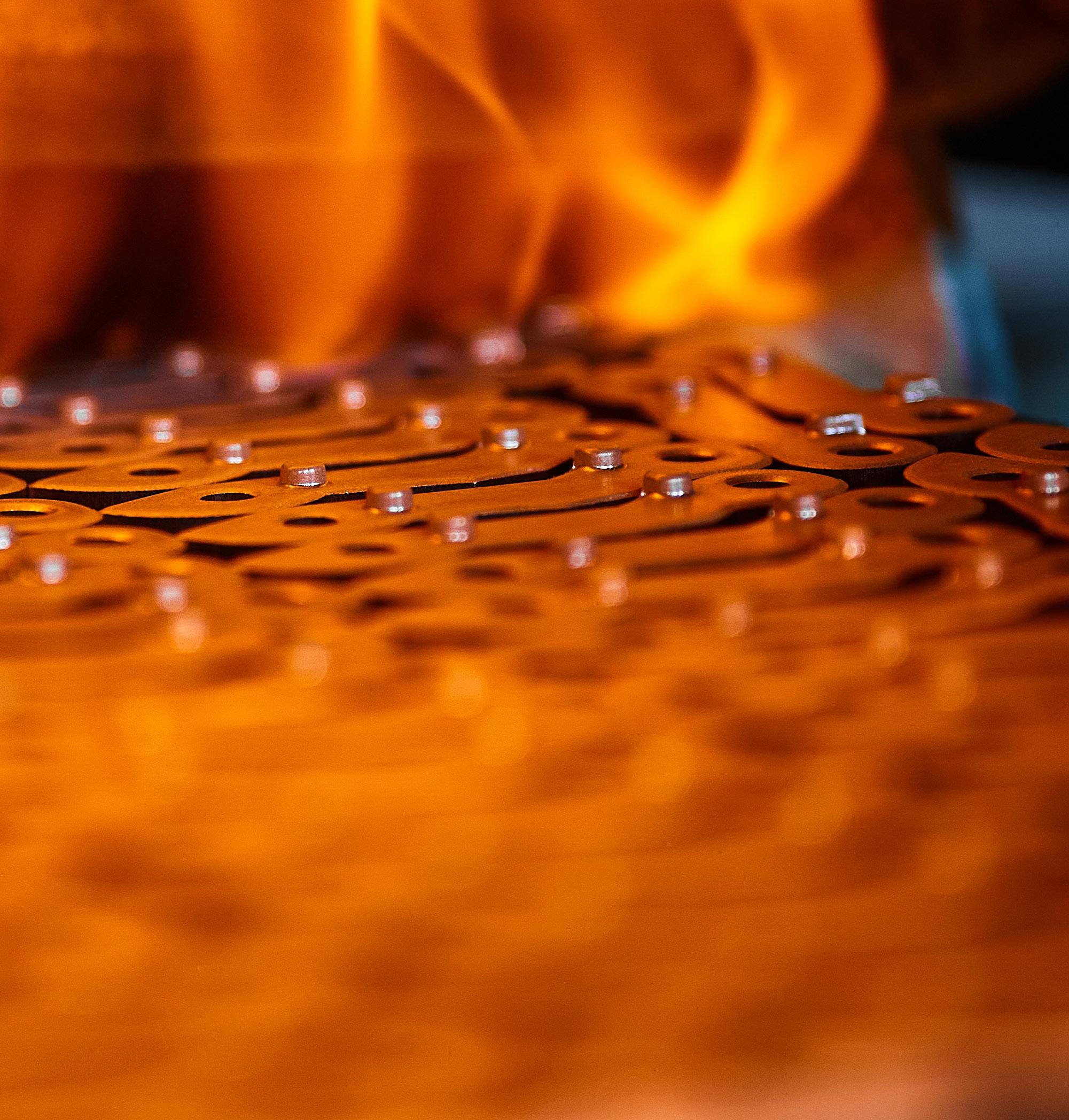
n.07/08 luglio-agosto 2023
Organo ufficiale dell’Associazione Italiana di Metallurgia.
Rivista fondata nel 1909
La Metallurgia Italiana
International Journal of the Italian Association for Metallurgy
Organo ufficiale dell’Associazione Italiana di Metallurgia. HouseorganofAIMItalianAssociationforMetallurgy. Rivista fondata nel 1909
Direttore responsabile/Chiefeditor: Mario Cusolito
Direttore vicario/Deputydirector: Gianangelo Camona
Comitato scientifico/Editorialpanel:
Marco Actis Grande, Silvia Barella, Paola Bassani, Christian Bernhard, Massimiliano Bestetti, Wolfgang Bleck, Franco Bonollo, Irene Calliari, Mariano Enrique Castrodeza, Emanuela Cerri, Vlatislav Deev, Andrea Di Schino, Donato Firrao, Bernd Kleimt, Carlo Mapelli, Denis Jean Mithieux, Roberto Montanari, Marco Ormellese, Mariapia Pedeferri, Massimo Pellizzari, Barbara Previtali, Evgeny S. Prusov, Dario Ripamonti, Dieter Senk
Segreteria di redazione/Editorialsecretary: Marta Verderi
Comitato di redazione/Editorialcommittee: Federica Bassani, Gianangelo Camona, Mario Cusolito, Carlo Mapelli, Federico Mazzolari, Marta Verderi, Silvano Panza
Direzione e redazione/Editorialandexecutiveoffice: AIM - Via F. Turati 8 - 20121 Milano tel. 02 76 02 11 32 - fax 02 76 02 05 51 met@aimnet.it - www.aimnet.it
Reg. Trib. Milano n. 499 del 18/9/1948. Sped. in abb. Post. - D.L.353/2003 (conv. L. 27/02/2004 n. 46) art. 1, comma 1, DCB UD
Immagine in copertina: Shutterstock
Gestione editoriale e pubblicità Publisher and marketing office: siderweb spa sb Via Don Milani, 5 - 25020 Flero (BS) tel. 030 25 400 06 - fax 030 25 400 41 commerciale@siderweb.com - www.siderweb.com

La riproduzione degli articoli e delle illustrazioni è permessa solo citando la fonte e previa autorizzazione della Direzione della rivista. Reproduction in whole or in part of articles and images is permitted only upon receipt of required permission and provided that the source is cited.
siderweb spa sb è iscritta al Roc con il num. 26116
Memorie scientifiche / Scientific papers
Trattamenti Termici / Heat Treatment
treatment of a Beta-Ti21S alloy produced by additive manufacturing

of ausforming temperature and strain on the bainitic transformation
of microalloying on tempering of Mo-W high thermal conductivity steel
of an optimal solutioning treatment for a Ni-based superalloy processed by Additive Manufacturing
Attualità industriale / Industry news Oxide scale modelling on low carbon steels: kinetics characterization and failure prediction during hot-deformation processes
Le aziende di AIM/AIM's companies
Controllo del processo ed efficienza energetica nella forgiatura mediante simulazione
Acciaio e metalli: dinamiche, cicli e tendende di mercato
notizie / AIM news
TRATTAMENTI TERMICI E SOSTENIBILITÀ
Il tema della sostenibilità sta assumendo sempre maggiore importanza anche nel settore dei trattamenti termici, con importanti ricadute su processi e prodotti. La necessità di ridurre i consumi energetici e le emissioni di CO2 sono alla base di percorsi virtuosi volti allo sviluppo dei processi esistenti e all’introduzione di novità, come l’impiego dell’idrogeno nei forni di riscaldo, ad esempio. Di questo e di molto altro si è discusso nel recente convegno europeo sui trattamenti termici (ECHT2023, European Conference on Heat Treatment) tenutosi a Genova dal 29 al 31 maggio, nella splendida cornice del porto antico, presso i magazzini del cotone. La manifestazione, organizzata in modo impeccabile da AIM, ha raccolto un buon numero di contributi scientifi-
HEAT TREATMENTS AND SUSTAINABILITY
The issue of sustainability is also becoming increasingly important in the heat treatment sector, with significant implications for processes and products. The need to reduce energy consumption and CO2 emissions are driving virtuous paths aimed at the development of existing processes and the introduction of innovations, such as the use of hydrogen in furnaces, for example. This and much more was discussed at the recent European Conference on Heat Treatment (ECHT2023) held in Genoa May 29-31 in the beautiful setting of the Old Port at the Cotton Warehouses. The event, impeccably organized by AIM, gathered a good number of scientific contributions, of excellent quality, that animated the discussion on the challenges that the
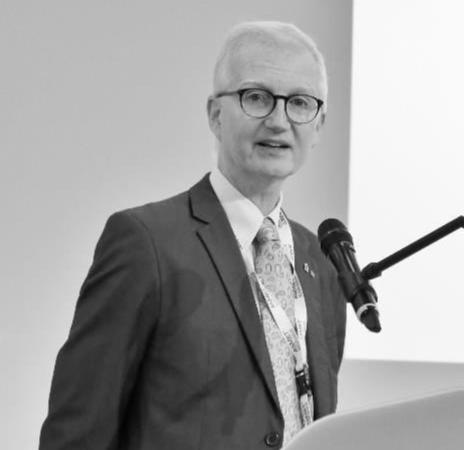
““Il tema della sostenibilità sta assumendo sempre maggiore importanza anche nel settore dei trattamenti termici, con importanti ricadute su processi e prodotti.”Prof. Massimo Pellizzari Dipartimento di Ingegneria Industriale, University of Trento
"The issue of sustainabilityisalso becomingincreasingly important in the heat treatment sector, with significantimplications for processes and products."
ci, di ottima qualità, che hanno animato il confronto sulle sfide che l’industria del trattamento termico è e sarà chiamata ad affrontare per contribuire al raggiungimento degli obiettivi imposti dalla Comunità Europea sul contenimento del riscaldamento globale e degli effetti sul clima. L’evento è stato anche occasione di incontro per le principali associazioni di categoria europee. Le memorie presentate dalla comunità scientifica e dal mondo dell’industria, soprattutto nella sessione di apertura “Heat Treatment and sustainability”, hanno illustrato interessanti e importanti passi in avanti nell’obiettivo di recuperare calore dai processi, di ridurre l’impatto ambientale attraverso l’impiego di fluidi di tempra ecologici, e di mappare gli aspetti legati alla sostenibilità nell’industria moderna attraverso la digitalizzazione. Ha riscosso ottimo successo anche la parte espositiva della manifestazione, grazie ai numerosi stand animati dalle aziende partecipanti. Il risultato è stata una manifestazione ben riuscita, capace di fornire ottimi spunti e stimoli per proseguire nel percorso verso trattamenti termici e superficiali sempre più sostenibili. Il convegno di Genova è stata anche l’occasione per ricordare l’ingegner Daniele Franchi, stimato tecnico e personaggio eclettico che ha sempre partecipato con grande dinamismo ed entusiasmo alla vita di AIM. Nell’intervento in sua memoria, Danilo Petta, già presidente del comitato tecnico trattamenti termici e metallografia, ha sottolineato le grandi qualità tecniche ed umane dell’amico scomparso.
A sottolineare l’attualità dell’argomento, di sostenibilità si è parlato anche nel corso della giornata di studio organizzata dal Comitato Tecnico Trattamenti Termici e Metallografia intitolata “La sostenibilità in trattamento termico” tenutasi presso l’azienda Agrati (Verduggio, MB). Questa volta in un quadro nazionale, si sono affrontate molte delle tematiche sopra richiamate attraverso gli interventi qualificati di aziende che hanno illustrato interessanti esempi di buone pratiche.
heat treatment industry is and will be called upon to face in order to contribute to the achievement of the objectives imposed by the European Community on the containment of global warming and climate effects. The event was also an opportunity for leading European trade associations to meet.
The papers presented by the scientific community and industry, especially in the opening session devoted to "Heat Treatment and sustainability", illustrated interesting and important steps forward in the goal of recoveringheatfromprocesses,reducingenvironmental impact through the use of environmentally friendly quenching fluids, and mapping sustainability aspects in modern industry through digitalization. The exhibition part of the event was also very successful, thanks to the many stands animated by the companies. The result was a well-executed event, capable of providing excellent insights and stimuli to continue on the path toward increasingly sustainable heat and surface treatments. The Genoa conference was also an opportunity to remember engineer Daniele Franchi, an esteemed and eclectic technician who always participated with great dynamism and enthusiasm in the life of AIM. In the speech in his memory, Danilo Petta, former chairman of the heat treatment and metallography technical committee, emphasized the great technical and human qualities of this late friend.
Underlining the importance of the topic, sustainability was also discussed during the workshop organized by the Technical Committee for Heat Treatments and Metallography of AIM entitled "Sustainability in Heat Treatment"heldattheAgraticompany(Verduggio,MB). This time in a national framework, many of the issues mentioned above were addressed through the qualified interventions of companies that illustrated interesting examples of best practices.
Certainly, the important challenges undertaken will require great and further efforts in the near future. It
Certamente, le importanti sfide intraprese richiederanno grandi ed ulteriori sforzi nel prossimo futuro. È auspicabile che l’importante accelerazione verso la sostenibilità emersa nelle manifestazioni organizzate da AIM consentirà di apprezzare presto gli effetti degli sforzi intrapresi. Per questo però, dovremo attendere i prossimi appuntamenti. Uno dei più importanti sarà la quarta edizione della Mediterranean Conference on Heat Treatment and Surface Engineering - MCHTSE 2024 che si terrà a Lecce, dal 17 al 19 aprile 2024, congiuntamente alla 5th International Conference on Thermal Process Modeling and Simulation - TPMS-5
is to be hoped that the important acceleration toward sustainability that has emerged in the events organized by AIM will enable the effects of the efforts undertaken to be appreciated soon. For this, however, we will have to wait for the upcoming events. One of the most important will be the 4th Mediterranean Conference on Heat Treatment and Surface Engineering - MCHTSE 2024 to be held in Lecce, Italy, April 17-19, 2024, jointly with the 5th International Conference on Thermal Process Modeling and Simulation - TPMS-5. Don't miss it!


Heat treatment of a Beta-Ti21S alloy produced by additive manufacturing
L. Emanuelli, V. Tonon, M. Pellizzari, G. Valsecchi, C. LoraMetastable β -Ti alloys are a class of heat-treatable materials increasing research interest nowadays. Their mechanical properties make them very suitable for high-end applications, such as racing and aerospace. In this study, the heat treatment behaviour of β -21S (Timetal 21S) fabricated by laser powder bed fusion (L-PBF) was investigated, to evaluate its influence on microstructure and mechanical properties. Solution heat treatment (SHT) at 930 °C x for 30 min allowed an equiaxed microstructure with no massive grain coarsening. Artificial ageing (AA) at 590 °C x 8h following SHT resulted in higher strength, compared to that achieved by direct ageing, and in α precipitation shifted to higher temperatures with a triangular arrangement. The suitability of two different direct ageing treatments, namely AA (590°C for 8h), and double ageing (DA) at 690°C for 8h plus 650°C for 8h, could be confirmed for the AM alloy. Both treatments provided strength values comparable to literature findings but also in an incredibly high elongation at break. AA provided a yield strength of about 1200 MPa and preserved the elongation at break of the as-built material (21%). On the other hand, the outstanding fracture elongation after DA (34%) led to a slightly lower strength (970 MPa). On the other hand, SHT+AA resulted in a higher strength (1286MPa) but also in very limited ductility (7%) due to the grain boundary precipitation of alpha phase.
KEYWORDS: METASTABLE BETA TITANIUM ALLOYS, TI-21S, HEAT TREATMENTS , LASER POWDER BED FUSION, ADDITIVE MANUFACTURING
INTRODUCTION
Titanium alloys, based on Ti with addition of elements such us Al, V, Fe and Mo, are of good interest in aerospace, automotive, military, medical, sporting and other applications where low-density (around 4.51 g/cm3) with high strength and high corrosion resistance are of primary importance [1,2]. In addition, their excellent biocompatibility and low elastic modulus compared with the other metallic biomaterials make them the far most used material in the orthodontic and orthopedic fields [3–5]. Titanium alloys are divided in three different classes, α , α + β , and β phase with further subdivision into near α and metastable β alloys depending on the alloying elements used to stabilize the two allotropic phases of Ti, namely hexagonal close-packed (hcp) α -phase and the body-centered cubic (bcc) β -phase. Indeed, alloying elements could be divided into α -stabilizers, namely Al, O, N and C, which extend the α field to higher temperatures
Scientific papers - Heat Treatment
and β -stabilizers, such as Mo, V, Ta, Nb, Fe, Mn, Cr, Co, Ni, Cu, Si and H, which decrease the β -transus temperature [2,6]. β -Ti alloys have progressively replaced iron and nickel based alloys in the aerospace industry thanks to the unique strength to weight ratio, excellent temperature resistance up to around 600°C and high hardenability [7,8]. Furthermore, they are having a growing interest in for biomedical applications thanks to the lower elastic modulus achieved with the β microstructure compared to the common metallic biomaterials [8]. A subgroup of the β -alloys is given by the metastable β -alloys which can be composed with a small volume fractions of other phases such as α , martensitic phases or ω -phase depending on composition and thermo-mechanical processing [4,7]. Among this group of β -alloys, β -21S, which is characterized by a chemical composition of Ti-15Mo-3Nb-3Al-0.2Si (wt.%), is of good interest in a variety of applications where high temperature strength, creep resistance, thermal stability and oxidation resistance are required [9,10]. With the aim of produce β -21S high complexity components, additive manufacturing (AM) technologies are gaining increasing interest thanks to the possibility to decrease the time and cost of production and high design freedom and good tolerance [11]. One of the most used AM techniques is the laser powder bed fusion (L-PBF) offering the best dimensional precision and accuracy [12]. Pellizzari et. Al. [10] have demonstrated the achievement of interesting properties for biomedical applications, namely a low elastic modulus e good mechanical properties, by producing β -21S alloys via L-PBF. Nevertheless, this alloy results in a promising candidate for strength applications thanks to precipitation hardening achieved through specific heat treatments. Typical heat treatment of cast and wrought Ti21S alloy involves solution heat treatment (SHT) above the β -transus temperature to recrystallize and recover anisotropy and guarantee homogenous response to the following artificial aging (AA) between 500 and 700°C [13]. Aging is aimed at strengthening the material through the precipitation of α phase inside grains. Depending on the required mechanical properties, aging at 500°C is used to achieve higher strength to toughness/ductility ratios; differently, aging at higher temperature leads to a recovering of the ductility at the expense of strength [14,15].
Two other heat treatments are commercially diffused for Ti21S, namely direct aging (AA) at around 590°C for 8h for low temperature applications and double aging (DA) at 690°C for 8h and 650°C for 8h when higher thermal stability is required [13].
In this work, heat treatment response of β -21S produced by L-PBF was investigated. Three different heat treatments (HTs), namely direct aging (AA), solution treatment followed by aging (STA) and double aging (DA) were performed. The effects of the different heat treatments on the microstructure, mechanical properties and residual stresses were evaluated.
MATERIALS AND METHODS
A β -Ti21S pre-alloyed powder (GKN Hoeganaes Corporation, USA, D10=25 μ m, D50=41 μ m, D90=60 μ m) was used. Dog-bone (ASTM E8M) samples were 3D printed with the main axis parallel to the building direction (BD) using a L-PBF machine model SISMA MYSINT100 on a platform of 100 mm in Ar atmosphere. A laser spot of 55 μ m, a power of 200W, a volume energy density comprised between 40 and 90 J/mm3 and a 90° scanning strategy were used. Heat treatments were carried out in a vacuum furnace, equipped with an all-metal molybdenum hot zone. Samples were placed horizontally inside the furnace, using nickel-based alloy fixtures. Once established high vacuum (1E-5/1E-6 mbar range of pressure), samples were heated 10°C/min to the selected temperature. After soaking, the samples were cooled to room temperature using pressurized argon at 1.5 bar for the aging treatments and pressurized argon at 6 bar for the solution heat treatment. During double aging (DA), samples were furnaced cooled (~ 1.3°C/min) from the Aging 1 temperature (690°C) to Aging 2 temperature (650°C). Details of the different heat treatments are summarized in Tab. 1.
Tab.1 - Heat treatments of tensile specimens. if not specified, heating rate is equal to 10°C/min and cooling rate of 30 °C/min
Tensile tests were carried out according to ASTM E8 at RT, with a strain rate of 1 mm/min and using an extensometer with a 12.5 mm gauge length to evaluate the elastic region of the curves. After sandblasting, three samples for each condition were tested. The microstructural characterization of as-built (AB) and HTs samples was carried out by light optical (LOM) and scanning electron microscopy (SEM) after proper metallographic preparation and chemical etching with Kroll’s reagent [16]. Fractographic analysis on the AB and HTs samples after tensile testing was performed by means of SEM. Cantilever tests, using the geometry reported by C. Pauzon et al. [17], were conducted to evaluate the accumulated residual stresses due to L-PBF, on the AB and HTs samples. Specific point of the cantilever (P1, P2 etc.) were measured with Coordinate Measuring Machine (CMM) Global DEA 07-07-07 equipped with a Renishaw SP600M scanning head after the detachment, by means of Electrical Discharge Machining
(EDM), of the thin supports that connect the cantilever with the platform.
RESULTS AND DISCUSSION Microstructural analysis
As built microstructure shown in Fig. 1a clearly evidences the 90° scanning strategy used during L-PBF. A fully dense material and a columnar β grain structure oriented along the building direction is observed (Fig. 1b). In addition, traces of melting pools and the epitaxial growth of β grain which takes place along the heat flow direction are detected. The partial remelting of previously consolidated layers promotes the extension of epitaxial growth of β grain up several millimeters in length with a thickness of around 10 μ m. The solidification structure, namely the grain orientation, is influenced by the local heat flow direction, which is almost parallel to the building direction [10,18].

After AA, the solidification microstructure and the melting pools are still visible. Indeed, the AA is not able to remove the solidification microstructure and the anisotropy introduced by L-PBF. Some α colonies at the β grain boundaries ( α GB) seems to be present, even though this should be confirmed by higher resolution techniques.
SEM micrograph (Fig. 2b) highlights presence of α phase with a banded and Widmanstätten morphology of a size lower than 1 μ m inside β grains confirming a predominant intragranular precipitation along specific directions. LOM and SEM micrographs of DA treatment are reported in Fig. 3.
The solidification microstructure characterized by elongated grains is preserved as in case of AA but only few melting pools boundaries are still visible (Fig. 3a). Higher amount of α GB respect to AA is observed in SEM micrograph (Fig. 3b). Near the α GB a thin layer of β -phase without precipitates is formed called precipitates free
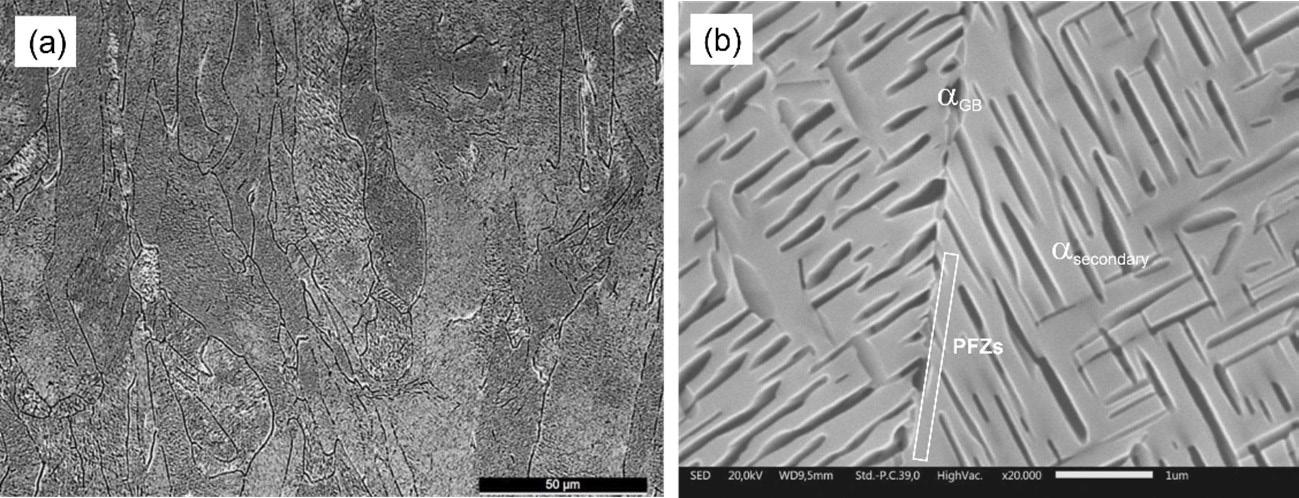

zones (PFZs). These zones increase the ductility of the alloy [19]. Secondary α precipitates inside the β grains with a specific orientation size of around 1-2 μ m. LOM and SEM micrographs achieved after STA (930°C for 30min + 590°C for 8h) treatment are shown in Fig. 4.
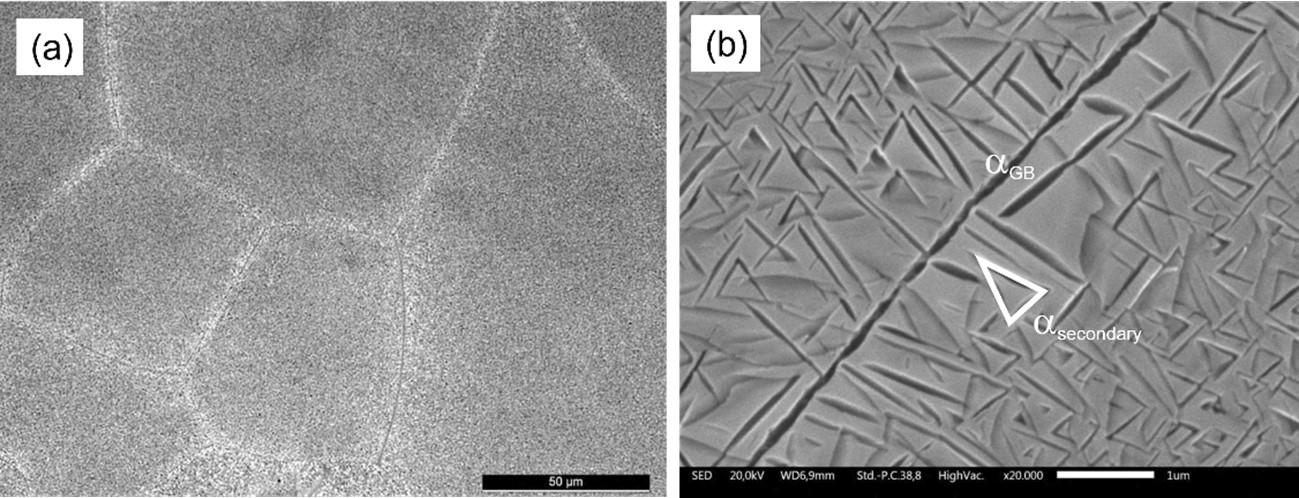
The solution heat treatment (SHT) promotes the recrystallization deleting the columnar structure achieved by L-PBF and creating equiaxed grains about 80 μ m in size. The high temperature reached during SHT then promotes a significant microstructural isotropy recovery. Thanks to homogenization, the precipitation of secondary α occurs with a peculiar triangular α lamellae arrangement (Fig. 4b). A thin
layer of α GB is observed highlighting a poor quench after ST.
Tensile tests
The nominal tensile stress-strain curves of AB and heat treated specimens are reported in Fig. 5a.
Fig.5 - a) Nominal tensile stress-strain curve of β -Ti21S obtained by L-PBF in AB condition and after three different HTs. b) Comparison between the mechanical properties achieved in this work and those reported in literature for the same wrought alloy and previous works on additively manufactured Ti-21S.
The corresponding mechanical properties are summarized in Tab. 2. The AB material shows an elastic modulus of 64 GPa, a fracture elongation around 22%, a yield strength of 804 MPa, and a UTS of 894MPa. Looking the AB stress-strain curve (Fig. 5a), after the first part related to elastic region, a
very intense work softening highlighting by a marked stress drop it is observed. This behavior is ascribed to the planar inhomogeneous plastic flow enhanced by an increased localized adiabatic temperature [20,21].
Tab.2 -Mechanical properties of β -Ti21S obtained by L-PBF in AB condition and after different HTs.
Heat treated samples show equal elastic modulus of 96GPa that is higher respect to the one of AB. This is ascribed to the precipitation of α phase that occurs in all three HTs as demonstrated through previous microstructural investigation. Comparing the HTs stress-strain curves with the one of AB, after yielding the strain softening
observed in AB is disappeared and is replaced by strain hardening leading to a material with a more predictable and controllable behavior. Direct aging (AA) leads to an increase in the strength with no significant variation in break elongation thanks to the precipitation of fine secondary alpha inside the β grains. Considering STA, the

higher strength respect to AA is accompanied by a marked drop in ductility, to be ascribed to the extended and rather continuous grain boundary precipitation of brittle α phase [22]. In case of DA thermal treatment, outstanding fracture elongation (34%) with slightly lower strength (970 MPa) respect to the other HTs and higher in comparison with AB is observed. The enhanced ductility compared with AA can be reasonably attributed to the formation of PFZs near the α GB (Fig. 4b). Differently, the slight decrease in strength respect to AA is due to the coarsening of secondary α [23].
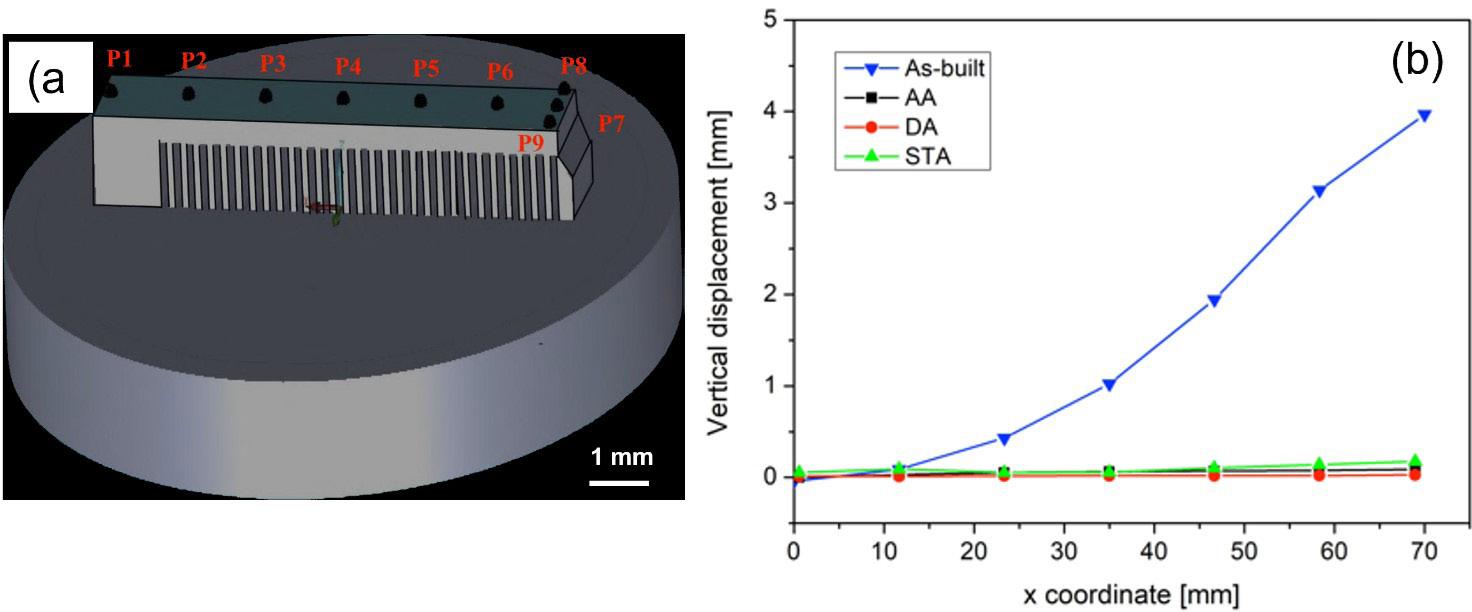
Comparison between the mechanical properties achieved in this work and those reported in literature for the same wrought alloy are shown in Fig. 5b. Except for the STA, the samples AB, AA and DA provide outstanding ductility near the highest values of wrought alloy and highest then the values refer to alloy obtained by means of AM. In terms of strength, highest values are obtained compared with other works on β -Ti21S AM alloy in all different conditions [9,10,13,21,24,25].
SEM fracture surface micrographs are reported in Fig. 6.

A ductile fracture surface highlighted by extended presence of dimples is observed in AB, AA and DA samples (Fig. 6a, b and c) differently from the STA samples where an intergranular fracture is highlighted (Fig. 6d). This is in agreement with the stress-strain curves that show a ductile behavior in case of AB, AA and DA and a drastic drop of the ductility in case of STA.
Cantilever test
The accumulated residual stresses due to L-PBF, on the AB and HTs samples are measured by means of cantilever test. The vertical displacement curves of the cantilever samples after detachment of the supports of the AB, AA, DA and STA specimens are shown in Fig. 7.
A evident vertical deflection after removal of the support is observed in case of AB since the release of stresses introduced by L-PBF. Differently, all HTs provide negligible vertical deflection thanks to the stress relieving, without particular differences for different HTs.
CONCLUSIONS
In this study, the heat treatment behaviour of β -Ti21S fabricated by L-PBF was investigated, to evaluate its influence on microstructure and mechanical properties. In details, direct aging (AA), double aging (DA) and solution heat treatment followed by artificial aging (STA) were carried out on dog-bone specimens. The main conclusion could be summarized as follows.
• Direct artificial aging of AB alloy at 590 °C x 8 h shows an increase in strength with no significant variation in break elongation thanks to the precipitation of fine secondary Widmannstätten- α platelets inside the β grains;
• Double aging treatment at 690 °C x 8 h + 650 °C x 8h permits to achieve outstanding fracture elongation (34%) due to the formation of PFZs and slightly lower strength respect to the other HTs involving ageing at lower temperature, due to coarsening of secondary α The enhanced ductility compared with the AA could be attributed to the formation of PFZs.
REFERENCES
• Solution heat treatment (SHT) at 930 °C x for 30 min promotes recrystallization of β grains deleting the columnar structure produced by L-PBF and allowed an equiaxed microstructure with no massive grain growth. Following artificial ageing (AA) at 590 °C x 8h resulted in higher strength, compared to that achieved by direct ageing, since the formation of secondary α with a triangular arrangement. The high ductility drop could be ascribed to the grain boundary precipitation of α phase that acts as a barrier to dislocation slip.
• Cantilever test confirmed the complete removal of residual stresses for all the three HTs.
In conclusion, direct ageing revealed itself a valid solution in providing appropriate mechanical properties and dimensional stability on the expenses of isotropy that can be recovered only by solution annealing.
Funding
This work is part of the project N. 2020.0042 - ID 50430, “Produzione additiva di protesi ortopediche a strut-tura trabecolare in Ti-beta” funded by Fondazione Cariverona.
Conflict of interest
The authors declare that they have no known financial interests or personal relationships that could have appeared to influence the work reported in this paper.
[1] F.H. Sam Froes, M. Qian, M. Niinomi, Titanium for consumer applications: Real world use of titanium, Titan. Consum. Appl. RealWorld Use Titan. (2019) 1–349. https://doi.org/10.1016/C2017-0-03513-9.
[2] Dr. Christoph Leyens, Dr. Manfred Peters, Titanium and Titanium Alloys, Titan. Titan. Alloy. (2003). https://doi.org/10.1002/3527602119.
[3] C. Sai Pitchi, A. Priyadarshini, G. Sana, S. Kumar Reddy Narala, A review on alloy composition and synthesis of b-Titanium alloys for biomedical applications, (2020). https://doi.org/10.1016/j.matpr.2020.02.468
[4] R.P. Kolli, A. Devaraj, A review of metastable beta titanium alloys, Metals (Basel). 8 (2018). https://doi.org/10.3390/MET8070506.
[5] C.S. Pitchi, A. Priyadarshini, G. Sana, S.K.R. Narala, A review on alloy composition and synthesis of β-Titanium alloys for biomedical applications, Mater. Today Proc. 26 (2020) 3297–3304. https://doi.org/10.1016/J.MATPR.2020.02.468
[6] J.C. Colombo-Pulgarín, C.A. Biffi, M. Vedani, D. Celentano, A. Sánchez-Egea, A.D. Boccardo, J.P. Ponthot, Beta Titanium Alloys Processed By Laser Powder Bed Fusion: A Review, J. Mater. Eng. Perform. 2021 309. 30 (2021) 6365–6388. https://doi.org/10.1007/ S11665-021-05800-6.
[7] R.R. Boyer, Aerospace applications of beta titanium alloys, JOM. 46 (1994) 20–23. https://doi.org/10.1007/BF03220743/METRICS
[8] S. Rajan Soundararajan, J. Vishnu, G. Manivasagam, N. Rao Muktinutalapati, Processing of Beta Titanium Alloys for Aerospace and Biomedical Applications, Titan. Alloy. - Nov. Asp. Their Process. [Working Title]. (2018). https://doi.org/10.5772/INTECHOPEN.81899.
[9] M.A. Macias-Sifuentes, C. Xu, O. Sanchez-Mata, S.Y. Kwon, S.E. Atabay, J.A. Muñiz-Lerma, M. Brochu, Microstructure and mechanical properties of β-21S Ti alloy fabricated through laser powder bed fusion, Prog. Addit. Manuf. 6 (2021) 417–430. https://doi.org/10.1007/ S40964-021-00181-7/FIGURES/16
[10] M. Pellizzari, A. Jam, M. Tschon, M. Fini, C. Lora, M. Benedetti, A 3D-printed ultra-low young’s modulus β-Ti alloy for biomedical applications, Materials (Basel). 13 (2020) 1–16. https://doi.org/10.3390/ma13122792
[11] J. Pelleg, Additive and Traditionally Manufactured Components: A Comparative Analysis of Mechanical Properties, Addit. Tradit. Manuf. Components A Comp. Anal. Mech. Prop. (2020) 1–642. https://doi.org/10.1016/C2019-0-04180-5
Scientific papers - Heat Treatment
[12] J. V. Gordon, S.P. Narra, R.W. Cunningham, H. Liu, H. Chen, R.M. Suter, J.L. Beuth, A.D. Rollett, Defect structure process maps for laser powder bed fusion additive manufacturing, Addit. Manuf. 36 (2020). https://doi.org/10.1016/J.ADDMA.2020.101552.
[13] J.D. Cotton, R.D. Briggs, R.R. Boyer, S. Tamirisakandala, P. Russo, N. Shchetnikov, J.C. Fanning, State of the Art in Beta Titanium Alloys for Airframe Applications, JOM. 67 (2015) 1281–1303. https://doi.org/10.1007/S11837-015-1442-4/FIGURES/25.
[14] T.W. Xu, H.C. Kou, J.S. Li, F.S. Zhang, Y. Feng, Effect of Phase Transformation Conditions on the Microstructure and Tensile Properties of Ti-3Al-15Mo-3Nb-0.2Si Alloy, J. Mater. Eng. Perform. 24 (2015) 3018–3025. https://doi.org/10.1007/S11665-015-15831/FIGURES/9
[15] S. Rajan Soundararajan, J. Vishnu, G. Manivasagam, N. Rao Muktinutalapati, Heat Treatment of Metastable Beta Titanium Alloys, Weld. - Mod. Top. (2021). https://doi.org/10.5772/INTECHOPEN.92301.
[16] S. Practice, Standard Practice for Microetching Metals and Alloys ASTM E-407, 07 (2016) 1–22. https://doi.org/10.1520/E040707R15E01.2.
[17] C. Pauzon, T. Mishurova, S. Evsevleev, S. Dubiez-Le Goff, S. Murugesan, G. Bruno, E. Hryha, Residual stresses and porosity in Ti-6Al4V produced by laser powder bed fusion as a function of process atmosphere and component design, Addit. Manuf. 47 (2021) 102340. https://doi.org/10.1016/J.ADDMA.2021.102340.
[18] A. Jam, A. du Plessis, C. Lora, S. Raghavendra, M. Pellizzari, M. Benedetti, Manufacturability of lattice structures fabricated by laser powder bed fusion: A novel biomedical application of the beta Ti-21S alloy, Addit. Manuf. 50 (2022) 102556. https://doi.org/10.1016/J. ADDMA.2021.102556.
[19] G. Lütjering, J. Albrecht, C. Sauer, T. Krull, The influence of soft, precipitate-free zones at grain boundaries in Ti and Al alloys on their fatigue and fracture behavior, Mater. Sci. Eng. A. 468–470 (2007) 201–209. https://doi.org/10.1016/J.MSEA.2006.07.168
TORNA ALL'INDICE >
Effect of ausforming temperature and strain on the bainitic transformation
M. Franceschi, L. Pezzato, M. DabalàIn this work, the effect of ausforming temperatures and strain level on bainitic transformation and morphology were investigated on a newly developed carbide-free high-silicon steel. High plastic deformations (0.2 ÷ 0.5%) were applied to undercooled austenite after austenitization in the temperature range 900-330 °C with a Gleeble 3800 thermomechanical simulator working in compression mode, before quenching or the isothermal treatment at 300 °C for bainitic transformation. Specimen characterization and the application of a thermodynamic approach showed that depending on the deformation temperature, before the bainitic transformation, strain-induced transformations that accelerate the transformation may occur. Moreover, it was observed a strong impact of the deformation temperature on bainite morphology including length of sheaves, size of the blocks, the reciprocal orientation of the bainitic plates and crystallographic orientations, with the detection of variant selection phenomena.
PAROLE CHIAVE: BAINITE, AUSFORMING, STEEL, RETAINED AUSTENITE, VARIANT SELECTION
INTRODUCTION
In recent years, nanostructured high-silicon carbidefree bainitic steels have been the protagonist of intensive research thanks to their exceptional combination of strength and ductility (1–3). Tensile strengths close to 2 GPa combined with fracture strains larger than 15 % are achieved thanks to a composite microstructure consisting of a matrix of bainitic ferrite, with nanoscaled thickness (<100 nm), and carbon-enriched retained austenite (4). These particular microstructures are obtained through isothermal treatments, called also austempering, after complete austenitization, at temperatures close to martensite start. The addition of silicon (wt. >1.5%) and aluminium inhibits cementite precipitation during the isothermal treatments, due to their low solubility in cementite, leading to the austenite carbon enrichment and stabilization after the carbon partitioning from the newly formed supersaturated bainitic ferrite. Austenite can be differentiated into two morphologies. The first is filmy-austenite, sandwiched between bainitic ferrite sub-units, characterized by high carbon content and, therefore, high mechanical and thermal stability. The second is represented by untransformed blocks located in the intersheaves space. Compared to the films, blocks are less carbon enriched and coarser, and if subjected to external loads, tends to exhibit TRIP effect (martensitic transformation induced by deformation), affecting the mechanical properties of the material. From these considerations it emerges that the heat treatment design
Scientific papers - Heat Treatment
must considered to limitate the block size and volume fraction in order to delay TRIP effect at high strain level. Nowadays, considering the actual environmental problems and the requirement of energy saving, coupled with the possibility of tailoring the properties of bainite through thermomechanical treatment, Ausforming is receiving great attention. Ausforming is a thermomechanical treatment that involves the plastic deformation of undercooled austenite, followed by a bainitic and/or martensitic transformation. Depending on the temperature at which austenite is deformed, it is possible to differentiate three ausforming regimes: i) High-temperature ausforming (HTA) close to the non-recrystallization temperature; ii) medium temperature ausforming (MTA) when the deformation is applied at temperatures between the ferrite/ pearlite and the bainite bays in the TTT diagram; iii) Lowtemperature ausforming (LTA), when the deformation is applied close to the transformation temperature. Among the advantages deriving the application of plastic deformation of the undercooled austenite, the most relevant are: the acceleration of the bainite reaction and the microstructural refinement. In addition, due to the displacive nature of the bainitic transformation ausforming is responsible for non-negligible microstructural changes that could affect the mechanical response of the material, such as the mechanical stabilization of austenite, stressstrain induced transformation during the deformation stage, variant selection phenomena (5).
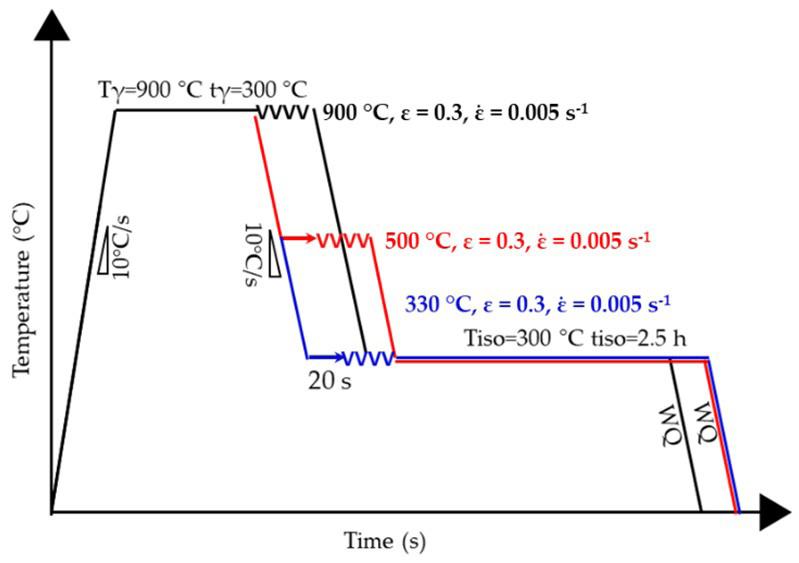
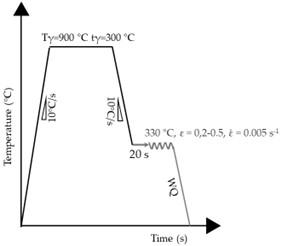
EXPERIMENTAL
Material and thermomechanical treatment-set up
The steel used in this work is a medium-carbon (0.38
wt.%), high-silicon (3.2 wt.%) carbide-free bainitic steel with composition developed by the authors (6,7), in form of cylindrical specimens with a diameter of 12 mm and length of 14 mm. The tests were performed, according to the scheme in Figure 1, with a Gleeble 3800 thermomechanical simulator equipped with a compressive deformation module, using silicon carbide punchers and graphite films to reduce friction. A first sample was austenitized at 900 °C for 5 minutes, (heating rate of 10 °C/s), subjected to a compressive deformation equal to 0.3 (strain rate 0.005 s-1) and subsequently cooled to 300 °C at 10 °C/s and isothermally held for 2.5 hours to ensure the completion of the bainitic transformation. The other specimens after austenitization were cooled at 10 °C/s to the deformation temperature (500 °C and 330 °C respectively) and isothermally held for 20 s to homogenize the temperature, and then subjected to deformation equal to 0.3 and strain rate 0.005 s-1. Similarly, after the deformation, the specimens were cooled to 300 °C, held for 2.5 hours and water quenched to room temperature. Finally, to investigate strain-induced transformations at low temperatures, two specimens were subjected to the same austenitization conditions, cooled at 330 °C, and after 20 s subjected to strains equal to 0.2 and 0.5. After the deformation specimens were water quenched at room temperature. The specimen’s temperature was monitored during thermomechanical processing through a K-thermocouple spot-welded on the specimen's central surface.
Microstructural investigation
Microstructural investigation was performed by means of scanning electron microscopy (LEO STEREOSCAN 440) after standard metallographic preparation, while the phase identification and quantification were carried out by X-ray diffraction (Siemens D500), equipped with a CuKα radiation tube, scanning an angular range of 2ϴ=40°105° with a speed of 0.5°/min. Rietveld analysis of the diffraction patterns was subsequently performed for the quantification of the phases present (Maud software) (8).
RESULTS AND DISCUSSION
The true stress-true strain curves, recordered during
ausforming treatments, are represented in Figure 2. The yield strength of the undercooled austenite at the various deformation temperatures was estimated by the 0.2% criterion (9), and the values are summarized in Figure 2. As expected, the values of yield strength increase with temperature decrease from 22 to 148 MPa. All the curves show a progressive increase in the true stress as the true strain increases, however, negative deflections were observed for the curves recorded at 900, and 500 °C due to recovery, and, at the highest temperature, recrystallization. Finally, these negative deflections are less pronounced as the deformation temperature decreases.
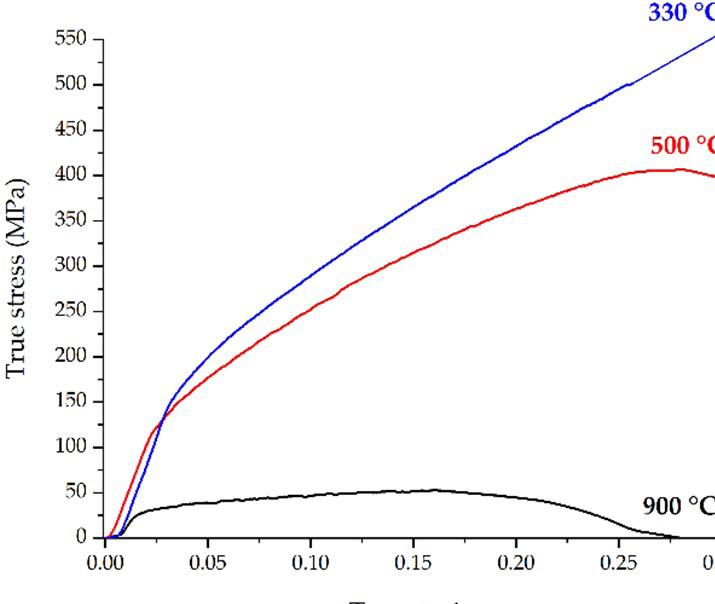

The SEM micrographs in Figure 3 display the microstructure after the pure isothermal treatments at 300 °C and after ausforming at the investigated temperatures. Compared to the pure isothermal treatment, where a microstructure consisting of bainitic ferrite and highcarbon enriched austenite, in form of blocks and films, with random orientation within the prior austenite grains. A similar microstructure can be observed after Ausforming at 900 °C since it does not introduce major modifications in the bainite morphology. Ausforming at 500 °C produces pancake-like grains and a more fragmented microstructure, with shorter sheaves and larger blocks of retained austenite. After deformation at 330 °C and
isothermal holding at 300 °C the microstructure exhibits a dramatic refinement of the plates that are preferably aligned at ± 45° to the deformation direction, leading to plates crossing each other with an angle of 90° and large blocks. Furthermore, as shown by the results of the Rietveld refinement, it is evident that as the deformation temperature decreases (from 900 °C to 330°C) the volume of retained austenite increases. On one hand, ausforming increases the number of nucleation sites for bainitic ferrite, leading to an increase in the final amount of bainite, while on the other hand deformation of undercooled austenite can imply a degree of mechanical stabilization of austenite, that hinders the formation of bainitic ferrite.
Moreover, even though the fraction of bainitic ferrite decreases, which is harder compared to austenite,
hardness increases, as a consequence of the refinement, and the strengthening of bainitic ferrite and austenite.
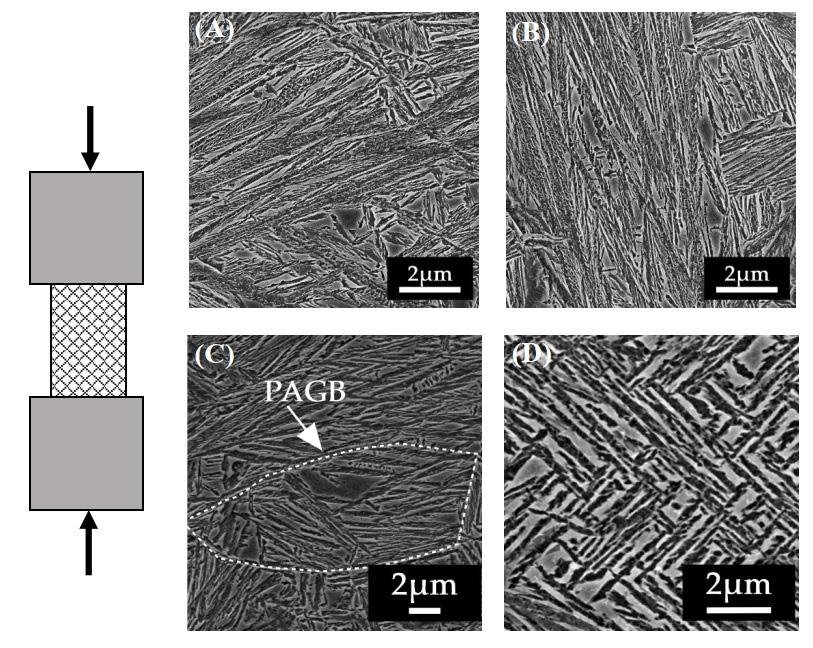
A closer look at the flow curves recorded at 300 °C led to observe that austenite continuously hardens at all the deformation levels, and, in addition, a continuous increase in dislocation density follows the application of the deformation without softening. However, the curve exhibits a linear behaviour only until a strain approximately 0.15, where inflection and a change in slope are observed. After single compression and water quenching to room temperature, the specimen microstructure consists of a martensitic matrix derived from the quenching to room temperature and bainitic plates within the grain, whose amount increases with the deformation. This inflection in
the stress-strain curves along with the detection of bainitic ferrite suggests that part of the phase transformation is induced by the strain and occurs owing to the application of plastic deformations, reaching completion during the isothermal holding. The presence of strain-induced bainitic transformation suggests also that bainitic transformation is accelerated by the application of lowtemperature ausforming treatments. The hypotheses find confirmation in the thermodynamic calculations provided in Figure 5, which shows that the application of the deformation increases the driving force for the bainitic transformation.
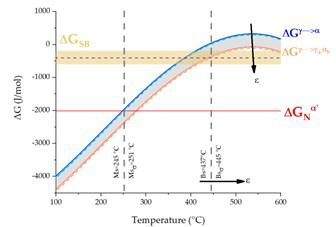
Fig.5 - Evolution of the driving force for the transformation of austenite to martensite/ bainite, showing the calculated critical onsets of both martensitic and bainitic transformation, considering only the composition, the thermal and the mechanical contribution,Msσ and Bsσ evaluation for the definition of the stress/strain-induced transformation field.

Scientific papers - Heat Treatment
CONCLUSION
The main conclusions that be summarized as follows:
• High-temperature ausforming at 900 °C has a minimal impact on the formed bainitic microstructure.
• Medium-temperature ausforming results in the formation of a fragmented bainitic microstructure.
• Low-temperature ausforming at 330 °C induces the major microstructural variations including the formation of plates that are preferably aligned at ± 45° to the deformation direction, leading to plates crossed plates at 90° (limited crystallographic variants) and
large blocks.
• The application of compressive strain at LTA leads to the formation of strain-induced bainite, accelerating the transformation and leading to the reduction of the time required for the completion.
• Compressive strain introduces defects that locally stabilizes the untransformed austenite hindering the transformation to bainitic ferrite.
BIBLIOGRAFIA
[1] Franceschi M, Soffritti C, Fortini A, Pezzato L, Garagnani GL, Dabalà M. Evaluation of wear resistance of a novel carbide- free bainitic steel. Tribol Int. 2023;178.
[2] Franceschi M, Bettanini AM, Pezzato L, Dabalà M, Jacques PJ. Effect of multi-step austempering treatment on the microstructure and mechanical properties of a high silicon carbide-free bainitic steel with bimodal bainite distribution. Metals (Basel). 2021;11(12).
[3] Caballero FG, Bhadeshia HKDH, Mawella KJA, Jones DG, Brown P. Very strong low temperature bainite. Mater Sci Technol. 2002;18(3):279–84.
[4] Garcia-Mateo C, Caballero FG. Understanding the Mechanical Properties of Nanostructured Bainite. Vol. 1, Handbook of Mechanical Nanostructuring. 2015. 35–65 p.
[5] Franceschi M, Bertolini R, Fabrizi A, Dabalà M, Pezzato L. Effect of ausforming temperature on bainite morphology in a 3.2% Si carbide-free bainitic steel. Mater Sci Eng A [Internet]. 2023; Available from: https://doi.org/10.1016/j.biteb.2019.100310
[6] Franceschi M, Pezzato L, Settimi AGAG, Gennari C, Pigato M, Polyakova M, et al. Effect of Different Austempering Heat Treatments on Corrosion Properties of High Silicon Steel. Materials (Basel). 2021;14(2):1–17.
[7] Franceschi M, Pezzato L, Gennari C, Fabrizi A, Polyakova M, Konstantinov D, et al. Effect of intercritical annealing and austempering on the microstructure and mechanical properties of a high silicon manganese steel. Metals (Basel). 2020;10(11):1–19.
[8] Lutterotti L. Maud: a Rietveld analysis program designed for the internet and experiment integration. Acta Crystallogr Sect A Found Crystallogr. 2000;56(s1):s54–s54.
[9] Eres-Castellanos A, Morales-Rivas L, Latz A, Caballero FG, Garcia-Mateo C. Effect of ausforming on the anisotropy of low temperature bainitic transformation. Mater Charact [Internet]. 2018;145(June):371–80. Available from: https://doi.org/10.1016/j. matchar.2018.08.062
Effect of microalloying on tempering of Mo-W high thermal conductivity steel
J. Burja, A. Nagode, J. Medved, T. Balaško, K. GrabnarThe effect of microalloying elements, niobium, tantalum and titanium on tempering, namely secondary hardening peaks was studied. The austenitisation temperatures, along with grain growth was studied. A high thermal conductivity hotwork tool steel was studied, with the following modifications Nb+0,06 w/% Nb, Ta+0,03 w/% Ta, and Ti+0,006 w/% Ti) based on reference (sample 0). Thermodynamic calculations were used to investigate the influence of microalloying on the transformation temperatures and carbide formation. The austenitisation temperatures of 1030, 1060, 1080 and 1100 °C were chosen and the samples were tempered at 540, 580, 600, 620 and 640 °C. The microstructure, hardness and grain size were investigated. The microalloying elements had a positive effect on grain size during austenitisation and on the increase of hardness during tempering. The microstructure was also investigated with electron microscopy. Mo-W carbides were dominant and showed coarsening and morphological changes, mainly rounding, during high temperature tempering. The secondary hardening peaks were reached at temperatures between 600 and 620 °C.
KEYWORDS: HOT WORK TOOL STEEL, MICROALLOYING, MOLYBDENUM, TUNGSTEN, TEMPERING, HEAT TREATMENT
INTRODUCTION
Hot-work tool steels are a superior grade of steel known for their outstanding mechanical properties at high temperatures, making them essential for various applications. They are commonly utilized in the production of dies for extrusion, forging, and die casting. These dies undergo rigorous cyclic mechanical and thermal stresses, as well as abrasion, and adhesion. Therefore, hot work tool steels need exhibit combination of strength, hardness, toughness, wear resistance, thermo-cyclic stability, and good thermal conductivity [1-6]. The damage to these steels is primarily caused by a combination of low cycle fatigue and thermal fatigue resulting from frequent temperature fluctuations during operation [7,8]. Controlled chemical composition and appropriate heat treatment are necessary to achieve the required mechanical properties of hot-work tool steel. The typical microstructure of these steels consists of tempered martensite and carbide precipitates [9-12]. The heat treatment process involves three stages: austenitizing, quenching, and tempering. In the austenitization process, undissolved carbides, nitrides, or carbonitrides inhibit the growth of austenite crystal grains, which is essential for achieving small crystal grains and adequate mechanical properties. Microalloying elements such as Nb, Ta, V, and Ti are added to suppress grain growth [5,12,18]. Carbide precipitates, however, play a crucial role in secondary
Institute of Metals and Technology, Slovenia
Aleš Nagode, Jožef Medved, Tilen Balaško
Department of Materials and Metallurgy, Faculty of Natural Sciences and Engineering, University of Ljubljana, Slovenia
Klemen Grabnar
Beni Tehing d.o.o., Slovenia
Scientific papers - Heat Treatment
hardening during tempering, with different carbide types forming depending on the chemical composition and tempering temperatures. However, above the maximum temperature for secondary hardening, carbides coarsen leading to softening of the steel [7]. The coarsening of carbides can be delayed to slow down the deterioration of the martensitic microstructure, maintaining high hardness and fatigue strength at higher temperatures and times. Therefore, understanding the microstructure evolution during tempering and service is crucial for controlling the tool life [22].
Previous studies have examined the impact of microalloying elements (V, Nb, or Ti) on the quenching and tempering process of low-alloy steels, as well as the composition and distribution of microalloyed carbides during tempering [14,23-25]. However, they have not studied the effect of microalloying elements on the tempering process of higher alloy steels that exhibit a secondary hardening peak, particularly Mo-W tool steels with high thermal conductivity values of up to 60 W·mK-1 [6,26,27]. Therefore, this study aims to investigate the effect of microalloying elements (Nb, Ta, and Ti) on the tempering process of Mo-W hot-work steel. The research will examine the role of microalloying elements in microstructural evolution
and the development of secondary hardening peaks during tempering.
MATERIALS AND METHODS
The experimental batches of the reference steel (0 – Tab. 1) were remelted in a vacuum induction melting furnace under 300 mbar argon. A total of four ingot measuring 60 x 60 x 400 mm and weighing 8 kg produced. The first batch of reference steel (0) was remelted without modification to the chemical composition. The second batch was remelted with the addition of 0.06 wt.% Nb (Nb – Tab. 1), the third batch was remelted with the addition of 0.03 wt.% Ta (Ta – Table 1) and the fourth charge was remelted with addition of 0.006 wt.% of Ti (Ti – Tab. 1). After casting, the ingots were cooled to room temperature in air. The microalloying additives were selected according to preliminary thermodynamic calculations. The aim was to form secondary carbides of the MC type in the austenite, but not primary MC carbides during solidification, as these can negatively influence the mechanical properties. The chemical composition (Tab. 1) was measured by optical emission spectrometry with inductively coupled plasma ICP-OES Agilent 720 and infrared absorption after combustion with ELTRA CS-800.
The ingots were annealed at 720 °C to relieve stress, then homogenized at 1200 °C for 1 h and hot rolled into 40 x 40 mm billets. After hot rolling, the billets air cooled. The billets were then additionally heated to 1100 °C and hot forged into 18 x 18 mm square bars. The bars were also air cooled. After cooling to room temperature, samples were soft annealed for 1.5 h at 770 °C. Then the samples were cut to the dimensions 18 x 18 x 60 mm. The hardening process was carried out in an electric resistance laboratory furnace with air atmosphere followed by oil quenching. The samples were placed in a furnace at room temperature, heated to 650 °C in 1 h and held for 20 min, then heated to 850 °C in 30 min and held again for 20 min and then heated to the quenching temperature in
45 min and held for 20 min. The quenching temperatures were 1030, 1060, 1080 and 1100 °C. The oil temperature was 60 °C. After oil quenching, the samples were tempered in a vacuum hardening furnace (Ipsen Turbo XL) under a protective atmosphere at temperatures of 540, 580, 600, 620 and 640 °C with a holding time of 2.5 h. The 2 mm of the surface layer were removed to avoid the influence of decarburisation.
The metallographic samples were ground, polished and etched with Nital 5%. The microstructure was analysed with an Olympus DP70 light microscope and a Thermo Scientific Quattro S field-emission scanning electron microscope with electron dispersive x-ray spectroscopy (EDS). Hardness values were measured on all investigated
samples using Vickers hardness method, HV10. The commercial software Thermo-Calc version 2022b was used for the CALPHAD calculations. The Thermo-Calc Software TCFE10 Steels/Fe-alloys database was selected to obtain the thermodynamic data for the calculations. We used the Equilibrium Calculator and selected the Property Diagram calculation type, from which we obtained diagrams showing the amount of thermodynamically stable phases in the samples studied.
RESULTS AND DISCUSSION
The results of CALPHAD calculations are summarized in Tab. 2. Thermodynamically stable phases of the investigated samples were calculated in the temperature range between 500 and 1300 °C. The Thermo-Calc designations are given with the corresponding phase and precipitation or
transformation temperatures. It is evident that the addition of microalloying elements (Nb, Ta and Ti) has no effect on the transformation temperature between ferrite and austenite (Ae3 and Ae1). It also has no influence on the precipitation temperature MC (WC), which is basically the same for all the samples studied. A slight influence on the precipitation temperature of the M6C carbides can be seen, with the addition of Nb increasing the temperature by 9 °C. The addition of Ti and Ta, on the other hand, has no influence on the precipitation temperature of the M6C carbides. The main difference is the precipitation of additional carbides based on the microalloying elements. In the Nb sample, there is additional precipitation of MC (NbC) carbides, which start to precipitate at 1253 °C. The same happens with the Ta and Ti samples, where TaC carbides start to precipitate at 1172 °C and TiC at 1057 °C.
The quenched and tempered samples exhibit a bainiticmartensitic microstructure. Furthermore, all samples were free of primary carbides. The hardness of the steel generally increases with higher
austenitisation temperatures (as shown in Fig. 1). At an austenitisation temperature of 1030°C, the steel without microalloying elements (0) exhibits an average hardness of 425 HV10. The addition of Nb and Ta did not affect
the increase in hardness at the given austenitisation temperature. However, the addition of titanium (Ti) was effective in increasing the hardness of the steel even at a
lower temperature, resulting in an average value of 446 HV10 after quenching.
The increase in the austenitisation temperature affected the increase in the size of the primary austenite crystal grains, especially of the reference sample (0) and the titaniumalloyed sample (Ti). Samples alloyed with niobium (Nb) and with tantalum (Ta) had a lesser effect on growth. At the highest austenitisation temperature of 1100 °C, all samples developed a coarse-grained microstructure. The hardness is most influenced by the change in the chemistry of the
austenite matrix before quenching, the resulting bainite/ martensite ration and the grain size. Examples of fine and coarse grained microstructures are presented in Fig. 2. The addition of niobium (Nb) and tantalum (Ta) had a large influence on the size of the crystal grains, which is also consistent with findings from literature sources [28,29]. A more detailed discussion on the grain growth mechanism in the samples is available in our previous work [5].
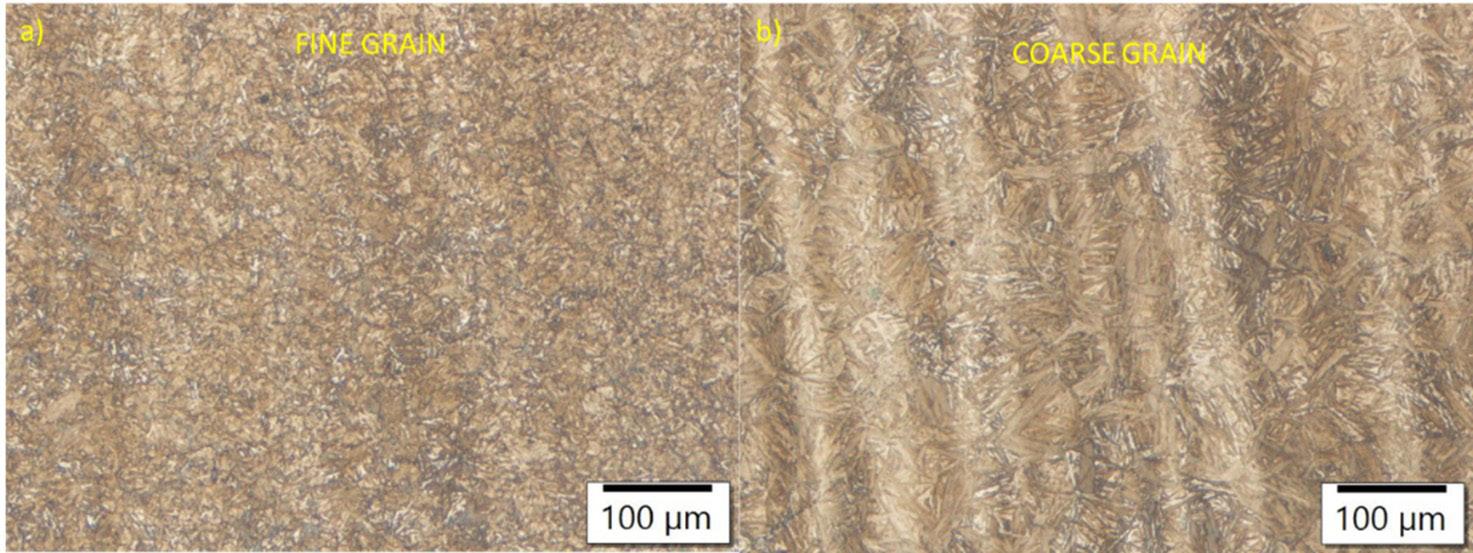
The samples were hardened at austenitising temperatures of 1030, 1060, 1080 and 1100 °C and tempered at temperatures of 540, 580, 600, 620 and 640 °C, which are most commonly used to temper tools to the required hardness. As mentioned before, the tempering times were 2.5 h after reaching temperature. With increasing tempering
temperature, a secondary hardness peak was reached in all samples. With increasing austenitisation temperature, the hardness after tempering and the value of the secondary peak hardness also increased. The highest secondary peak hardness values were achieved in the austenitisation temperature interval between 1080 and 1100 °C. The
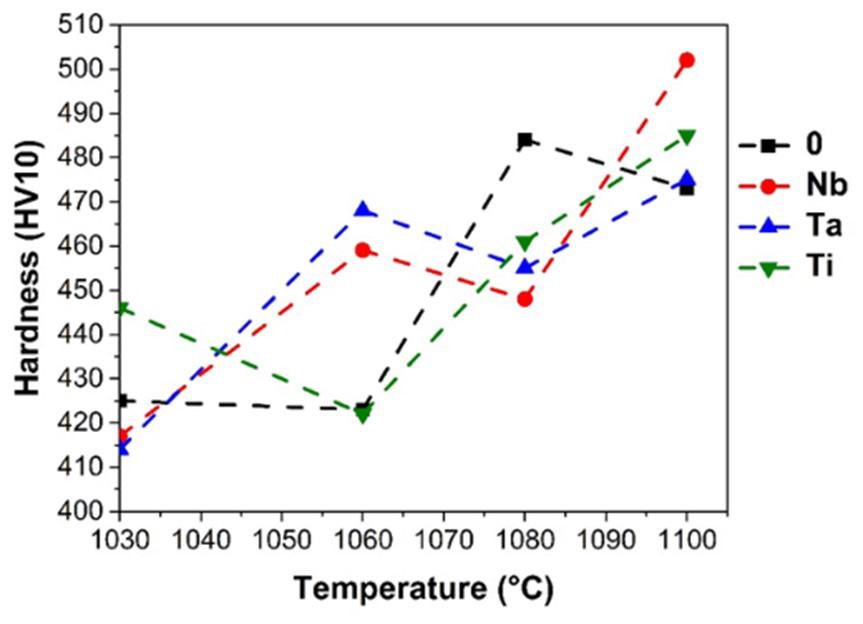
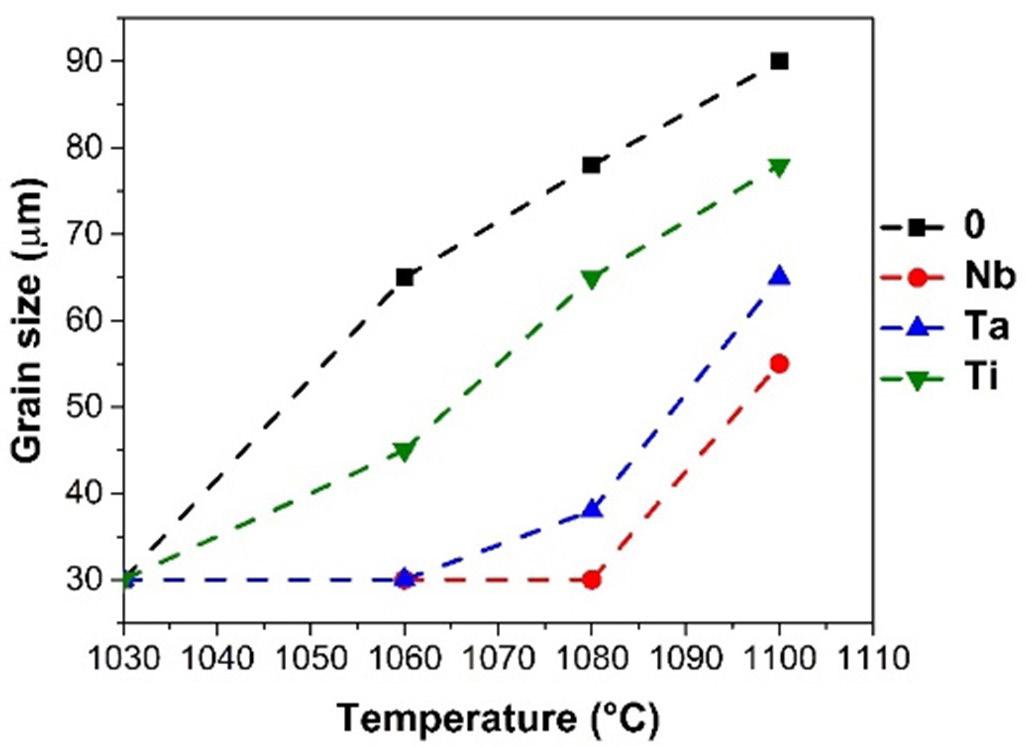
alloying elements niobium, tantalum and titanium had an influence on the increase of the strength properties in the temperature range between 540 and 640 °C. At an austenitisation temperature of 1030 °C (Fig. 3a), the Ti sample exhibits the maximum secondary peak hardness of 506 HV10. At the austenitisation temperature of 1060 °C
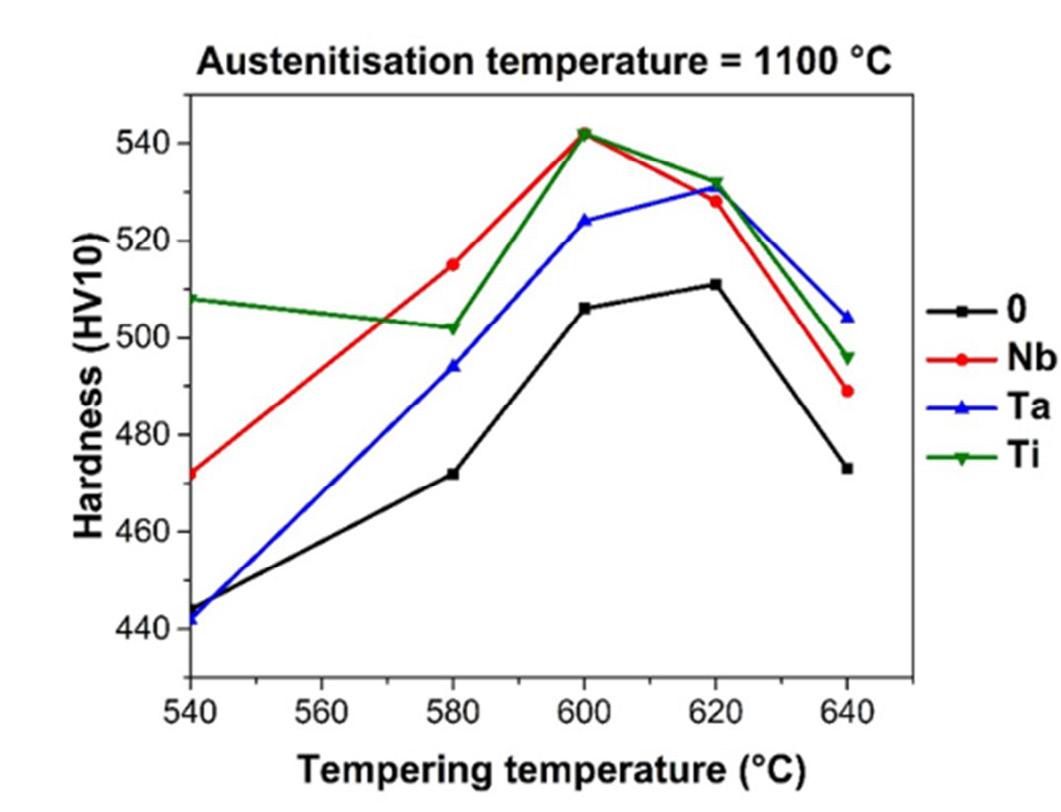
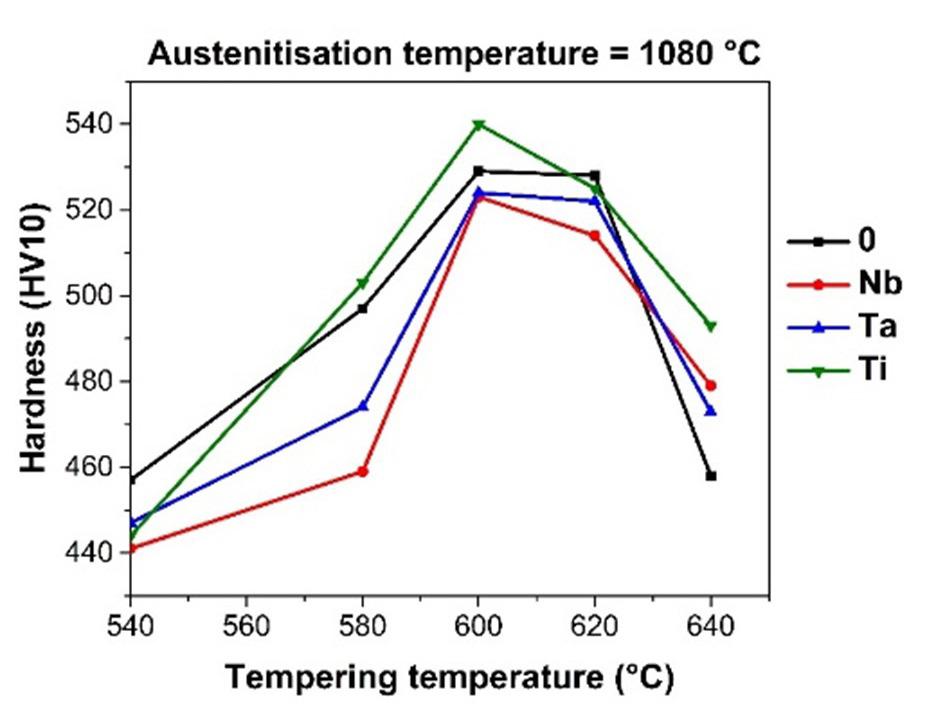
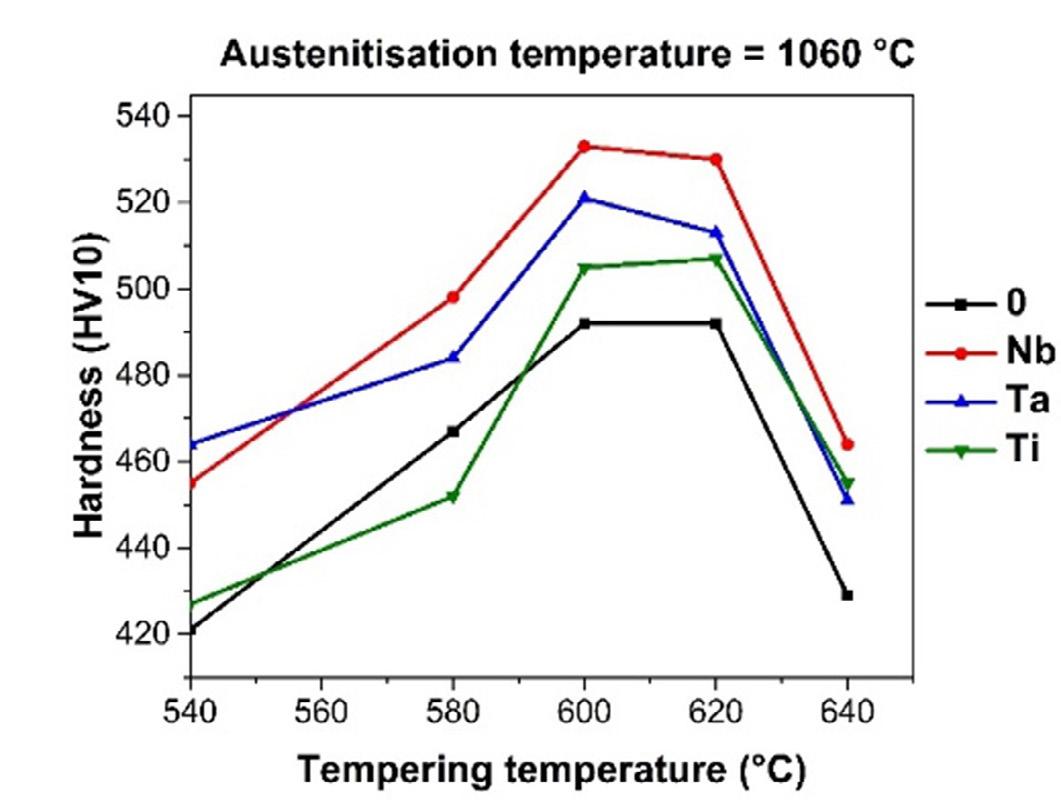

(Fig. 3b), the maximum secondary peak hardness of the Nb sample is 533 HV10. At an austenitisation temperature of 1080 °C (Fig. 3c), the maximum secondary peak hardness of Ti sample is 540 HV10. At an austenitisation temperature of 1100 °C (Fig. 3d), the maximum secondary peak hardness of Nb and Ti samples is 542 HV.
CONCLUSIONS
The following conclusions can be drawn from the paper:
• The microalloying elements, especially Nb and Ta were effective at pinning grain boundaries during austenitisation, up to 1100 °C.
• The secondary hardening peak for Mo-W high thermal conductivity steel is between 600 and 620 °C, for all the investigated heat treatment regimes.
• The microalloying elements influenced the hardness after tempering, mostly by increasing it, especially at the lowest 1030 °C and the highest 1080 °C austenitisation temperatures.
Scientific papers - Heat Treatment
REFERENCES
[1] Eser, A.; Broeckmann, C.; Simsir, C. Multiscale modeling of tempering of AISI H13 hot-work tool steel - Part 1: Prediction of microstructure evolution and coupling with mechanical properties. Comput. Mater. Sci. 2016, 113, 280–291.
[2] Li, J. Y.; Chen, Y. L.; Huo, J. H. Mechanism of improvement on strength and toughness of H13 die steel by nitrogen. Mater. Sci. Eng. A 2015, 640, 16–23.
[3] Wu, R.; Li, W.; Chen, M.; Huang, S.; Hu, T. Improved mechanical properties by nanosize tungsten-molybdenum carbides in tungsten containing hot work die steels. Mater. Sci. Eng. A 2021, 812, 141140.
[4] Markežič, R.; Mole, N.; Naglič, I.; Šturm, R. Time and temperature dependent softening of H11 hot-work tool steel and definition of an anisothermal tempering kinetic model. Mater. Today Commun. 2020, 22.
[5] Grabnar, Klemen; Burja, Jaka; Balaško, Tilen; Nagode, Aleš; Medved, J. The influence of Nb, Ta and Ti modification on hot-work toolsteel grain growth during austenitization. Mater. Technol. 2022, 56, 331–338.
[6] Vončina, M.; Balaško, T.; Medved, J.; Nagode, A. Interface reaction between molten Al99.7 aluminum alloy and various tool steels. Materials. 2021, 14.
[7] De Cooman, B. C.; Speer, J. G. Fundamentals of Steel Product Physical Metallurgy; AIST, Association for Iron & Steel Technology: Warrendale, PA, USA, 2011.
[8] Podgornik, B.; Sedlacek, M.; Žužek, B.; Guštin, A. Properties of tool steels and their importance when used in a coated system. Coatings 2020, 10.
[9] Zhou, Q.; Wu, X.; Shi, N.; Li, J.; Min, N. Microstructure evolution and kinetic analysis of DM hot-work die steels during tempering. Mater. Sci. Eng. A 2011, 528, 5696–5700.
[10] Medvedeva, A.; Bergström, J.; Gunnarsson, S.; Andersson, J. High-temperature properties and microstructural stability of hot-work tool steels. Mater. Sci. Eng. A 2009, 523, 39–46.
[11] Dhokey, N. B.; Maske, S. S.; Ghosh, P. Effect of tempering and cryogenic treatment on wear and mechanical properties of hot work tool steel (H13). Mater. Today Proc. 2021, 43, 3006–3013.
[12] Cabrol, E.; Bellot, C.; Lamesle, P.; Delagnes, D.; Povoden-Karadeniz, E. Experimental investigation and thermodynamic modeling of molybdenum and vanadium-containing carbide hardened iron-based alloys. J. Alloys Compd. 2013, 556, 203–209.
[13] Chen, K.; Jiang, Z.; Liu, F.; Yu, J.; Li, Y.; Gong, W.; Chen, C. Effect of quenching and tempering temperature on microstructure and tensile properties of microalloyed ultra-high strength suspension spring steel. Mater. Sci. Eng. A 2019, 766.
[14] Yang, G.; Sun, X.; Li, Z.; Li, X.; Yong, Q. Effects of vanadium on the microstructure and mechanical properties of a high strength low alloy martensite steel. Mater. Des. 2013, 50, 102–107.
[15] Zhang, C.; Wang, Q.; Ren, J.; Li, R.; Wang, M.; Zhang, F.; Sun, K. Effect of martensitic morphology on mechanical properties of an asquenched and tempered 25CrMo48V steel. Mater. Sci. Eng. A 2012, 534, 339–346.
[16] Wang, C.; Wang, M.; Shi, J.; Hui, W.; Dong, H. Effect of microstructural refinement on the toughness of low carbon martensitic steel. Scr. Mater. 2008, 58, 492–495.
[17] Haiko, O.; Javaheri, V.; Valtonen, K.; Kaijalainen, A.; Hannula, J.; Kömi, J. Effect of prior austenite grain size on the abrasive wear resistance of ultra-high strength martensitic steels. Wear 2020, 454–455, 13–16.
[18] Karmakar, A.; Kundu, S.; Roy, S.; Neogy, S.; Srivastava, D.; Chakrabarti, D. Effect of microalloying elements on austenite grain growth in Nb-Ti and Nb-V steels. Mater. Sci. Technol. (United Kingdom) 2014, 30, 653–664.
[19] Hollomon, J.H; Jaffe, L. D. TitleTime–temperature relations in tempering steels; 1975; Vol. 162.
[20] Mazurkiewicz, J.; Dobrzański, L. A.; Hajduczek, E. Comparison of the secondary hardness effect after tempering of the hot-work tool steels. 2007, 24, 119–122.
[21] Leskovšek, V.; Šuštaršič, B.; Jutriša, G. The influence of austenitizing and tempering temperature on the hardness and fracture toughness of hot-worked H11 tool steel. J. Mater. Process. Technol. 2006, 178, 328–334.
[22] Yang, H.; Zhang, J. H.; Xu, Y.; Meyers, M. A. Microstructural characterization of the shear bands in Fe-Cr-Ni single crystal by EBSD. J. Mater. Sci. Technol. 2008, 24, 819–828.
[23] Janovec, J.; Svoboda, M.; Výrostková, A.; Kroupa, A. Time-temperature-precipitation diagrams of carbide evolution in low alloy steels. Mater. Sci. Eng. A 2005, 402, 288–293.
[24] Jung, J. G.; Park, J. S.; Kim, J.; Lee, Y. K. Carbide precipitation kinetics in austenite of a Nb-Ti-V microalloyed steel. Mater. Sci. Eng. A 2011, 528, 5529–5535.
[25] Dong, J.; Zhou, X.; Liu, Y.; Li, C.; Liu, C.; Guo, Q. Carbide precipitation in Nb-V-Ti microalloyed ultra-high strength steel during tempering. Mater. Sci. Eng. A 2017, 683, 215–226.
[26] Kaschnitz, E.; Hofer, P.; Funk, W. Thermophysical properties of a hot-work tool-steel with high thermal conductivity. Int. J. Thermophys. 2013, 34, 843–850.
[27] Valls, I.; Hamasaiid, A.; Padré, A. High Thermal Conductivity and High Wear Resistance Tool Steels for cost-effective Hot Stamping Tools. J. Phys. Conf. Ser. 2017, 896.
[28] Chen, J.; Liu, C.; Liu, Y.; Yan, B.; Li, H. Effects of tantalum content on the microstructure and mechanical properties of low-carbon RAFM steel. J. Nucl. Mater. 2016, 479, 295–301.
[29] Foder, J.; Burja, J.; Klančnik, G. Grain size evolution and mechanical properties of Nb, V–Nb, and Ti–Nb boron type S1100QL steels. Metals. 2021, 11, 1–16.
Definition of an optimal solutioning treatment for a Ni-based superalloy processed by Additive Manufacturing
P.A. Martelli, M.S. Kenevisi, E. Bassini, D. UguesThe current work aims at defining an optimal recipe for the solution annealing (SA) of a high-fraction γ’ Ni-based superalloy manufactured with Laser Powder Bed Fusion process (PBF-LB/M). The studied alloy is designed for the aeronautical or energy sectors to perform above 800°C. The microstructure obtained from PBF-LB/M process (asbuilt state) is extremely fine with grains aligned along the building direction, due to the thermal flow during the process. Moreover, due to the fast cooling, the main reinforcing phase (γ’, a Ni3(Al,Ti) ordered L12 precipitate) cannot precipitate. SA temperatures of 1230°C, 1245°C and 1260°C were investigated to obtain the best microstructure in terms of reinforcing precipitates’ size, shape and fraction and grain size, keeping the soaking time constant (2 hours). Then, a first aging (FA) was also applied at 1095°C for 4 hours. The test plan was configured to account for industrial furnaces thermal uncertainty, introducing also higher temperatures to verify the presence of any thermal induced porosities (TIPs) or incipient melting traces. The morphology, size and volume fraction of γ ’ phase were assessed and quantified using scanning electron microscopy (SEM). Light optical microscopy (LOM) was used to evaluate the grains aspect ratio and growth during SA.
KEYWORDS: NICKEL SUPERALLOY, HEAT TREATMENT, ADDITIVE MANUFACTURING, PBF/LB, PRECIPITATION HARDENING, GRAIN COARSENING
INTRODUCTION
Ni-based superalloys are typically used in high temperature environment such as aeronautics and energy production, due to their outstanding thermo-mechanical properties and resistance to oxidation (1). Among others, René 80 is mainly reinforced by precipitation hardening of L12 ordered Ni3(Al,Ti) phase γ’ in a face-centered cubic (FCC) matrix γ. René 80 is traditionally processed by investment casting (2), but additive manufacturing techniques are gaining interest due to the capability to produce complex near-net shape components. In particular, Laser Powder Bed Fusion (PBF-LB) has already given promising results in terms of densification of such alloy (3). However, a peculiar microstructure is originated after the rapid heatingcooling cycles of PBF-LB process. More specifically, René 80 shows a cellular structure within fine grains elongated along the building direction (3). To optimize the asbuilt microstructure, solution annealing (SA) and aging treatments are necessary to guarantee the optimal shape, fraction and size of the reinforcing γ’ precipitates as well as grains’ recrystallization and coarsening (4). When it comes to additive manufacturing, the complex and new
Politecnico di Torino and Centro Interdipartimentale Integrated Additive Manufacturing, Italy
Politecnico di Torino, Centro Interdipartimentale Integrated Additive Manufacturing and Consorzio Nazionale della Scienza e Tecnologia dei Materiali, Italy
Scientific papers - Heat Treatment
microstructure originated from the printing stage requires different treatment conditions with respect to the traditional processes, after which SA is typically performed at 1204°C (5,6). For this reason, the commonly adopted annealing temperatures should be changed accordingly. The aim of the present work is to provide an optimized SA + first aging (FA) recipe, demonstrating that older heat treatments are less effective when applied to additively manufactured materials. Optimized process parameters (3) were used to process René 80 powders and different temperatures were studied to find the γ’ solvus temperature and the optimal SA condition in terms of precipitates’ size, morphology and fraction using scanning electron microscopy (SEM). Grains’ recrystallization and growth process was also assessed using light optical microscopy (LOM). FA was
performed at 1095°C for 4 hours. The results demonstrated that the SA temperature shall be set at 1260°C to achieve the full dissolution of γ’ and grains’ recrystallization. Given the typical thermal variability of industrial furnaces, one sample was also treated raising the SA to 1270°C to assess possible thermal induced porosities (TIP) formation or incipient melting.
MATERIALS AND METHODS
Material and samples production
The raw material used for producing the samples is a gas atomized powder commercialised as Ni-183 by Praxair Inc. The nominal composition of René 80 is reported in Tab. 1. The powders were sieved by the manufacturer in the range of 16 to 45μm.
Cubic samples of 20mm of edge were produced using a PrintSharp250 system by Prima Additive with a 250x250mm carbon steel platform heated to 80°C and a rubber recoater.
Printing parameters were optimised by the authors in a previous work (3) and are summarized in Tab. 2. Each stripe of the scanning was rotated of 67° between each layer.
Main parameters optimization range
Post processing
Samples were cut from the building platform using Wire Electro Discharge Machining (WEDM) and they underwent a stress relief treatment at 1080°C for 2 hours. After this step, solution annealing (SA) and first aging (FA) were applied in a low-pressure furnace TAV mini jet. The SA was carried out at 1230°C, 1245°C and 1260°C for 2 hours, then gas cooling with nitrogen at about 100°C/min was applied to reach the first aging temperature (1095°C), which was maintained for 4 hours. Finally, another sample underwent SA at 1270°C for 2h + FA to assess the risk of thermal induced porosities (TIPs) formation and incipient melting.
Samples preparation and investigation
Samples were metallography prepared along the building direction (XZ plane). Sections were embedded in resin and ground with SiC papers up to 1200 grit and polished with diamond suspensions of 6-3-1μm. Colloidal silica of 0.04μm was used to reach the final surface finishing. The γ’ morphology was assessed using a Zeiss EVO15 Scanning Electron Microscope (SEM) after electrolytic etching with H3PO4 (30%vol. in distilled water) at 3.5V. Chemical etching with Kalling n°2 solution was used to measure size and volume fraction of secondary γ’; for this purpose, six backscattered electron images at 10.00kX were analysed with an ImageJ algorithm developed by the authors. Grain size was
measured both along (Z-dir) and across (X-dir) building direction using the linear intercept method (ASTM E11213) on three images at 100X taken with a Leica DZ500 light optical microscope (LOM).
Hardness test
Brinell hardness tests were performed according to ASTM E10-18 with a force of 62.5 kg (HB10) on each sample, with 3 repetitions on the XZ plane, using a EMCOTEST M4U 025 system.
RESULTS
Microstructure evolution after solution annealing and first aging treatments
Fig. 1 shows the microstructure after the SA performed at different temperatures ranging from 1230°C to 1260°C. The electrolytic etching dissolved the γ matrix (yellow arrow), making the precipitates (black arrow) clearly visible.

After SA at 1230°C, γ’ is still irregular in shape. On the other hand, when the SA temperature is increased up to 1245°C and 1260°C, precipitates become cubic and regularly arranged. Back-scattered electron images were used to assess the size of γ’ precipitates and results are shown in Fig. 2. The mean size of γ’ remained quite constant and was calculated to be 239+/-114nm annealing at 1230°C, 283+/-133nm at 1245°C and 264+/-109nm at 1260°C. A similar result was obtained for the γ’ fraction, which was 20.4+/-0.5%, 22.3+/-1.1% and 21.4+/-4.2% after SA at
1230°C, 1245°C and 1260°C, respectively. The results can be considered independent from the SA temperature, considering the measure uncertainty. The main difference between the treatment conditions lays in the morphology of secondary γ’. The results show that at 1230°C the proper SA temperature is not reached, while starting from 1245°C the γ’ dissolution is effective and the further precipitation and aging lead to precipitates having a regular cuboidal shape.
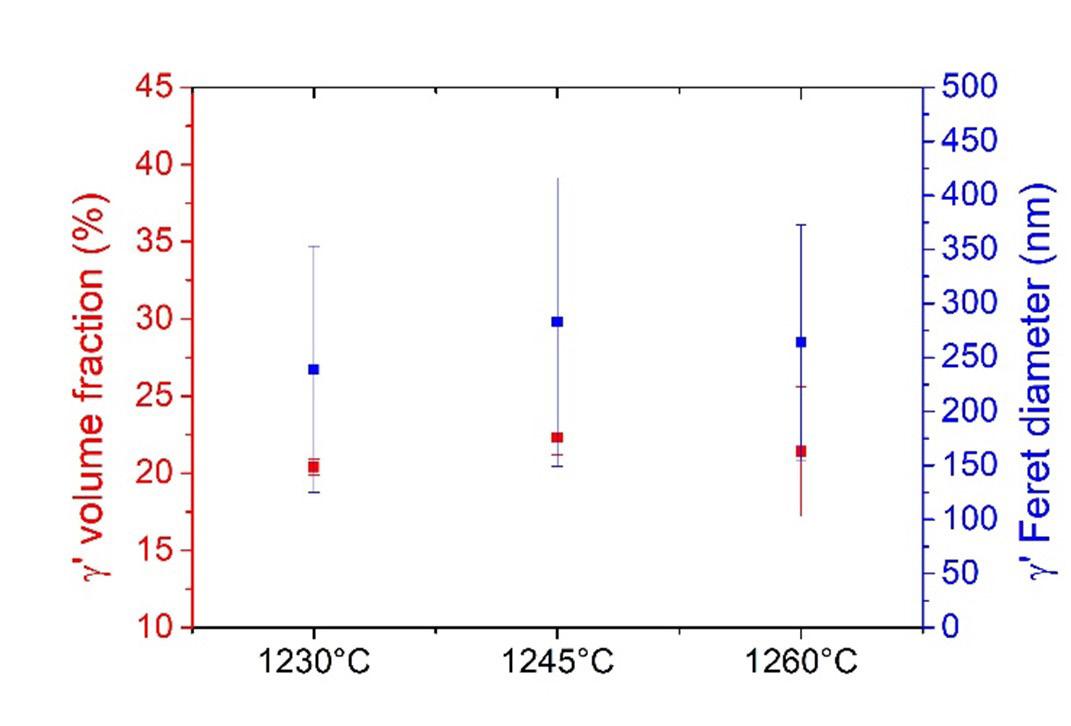
Scientific papers - Heat Treatment
The different SA treatments also led to different grain structures (Fig. 3). The sample treated at 1230°C still shows thin and elongated grains due to the additive manufacturing process (Fig. 3a), which demonstrates that the applied temperature was insufficient to promote a complete recrystallization. Traces of recrystallization can be observed when the SA is performed at 1245°C. More
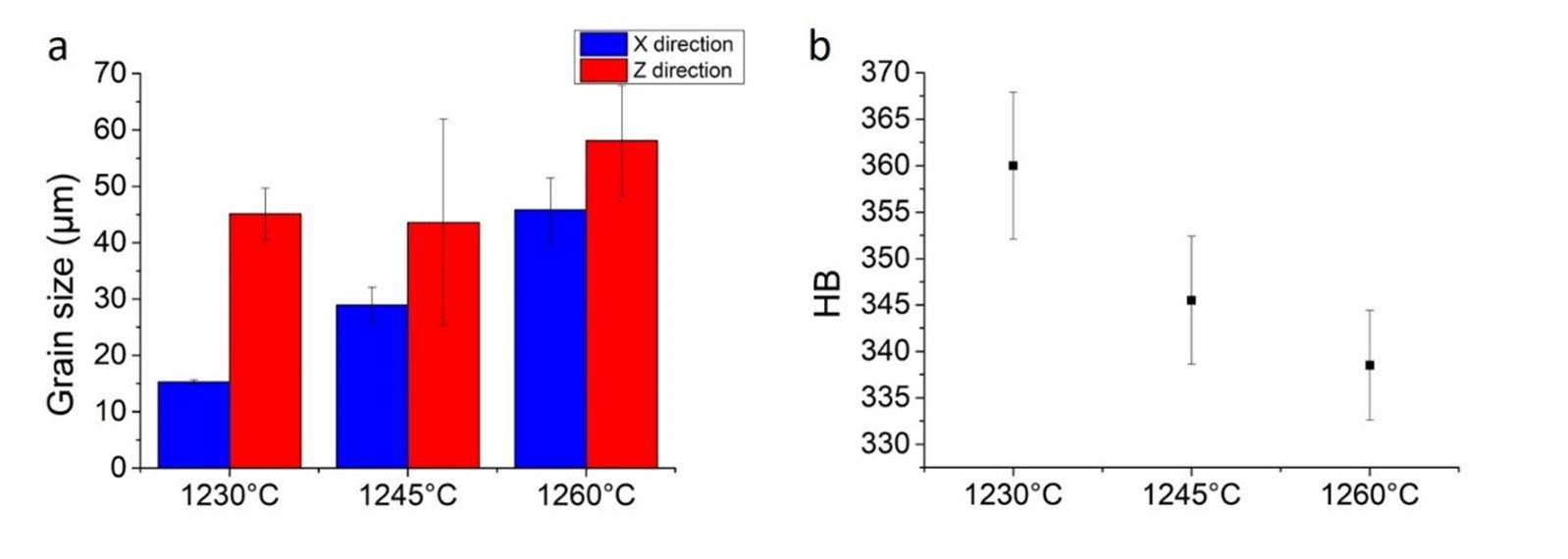
specifically, larger grains with an aspect ratio closer to unity can be seen (Fig. 3b). In particular, small areas with equiaxial grains can be detected (red circle). Finally, SA at 1260°C led to a fully recrystallized structure (Fig. 3c), which is testified by the diffuse presence of equiaxal grains.

Grain size was assessed and the values are reported in Fig. 4a. Increasing the SA temperature, the grain size measured along the X direction (perpendicular to the building direction) increases from 15.3+/-0.4μm at 1230°C to 28.9+/-3.2μm and 45.8+/-5.7μm at 1245°C and 1260°C, respectively. Along the building direction (Z) the grain size is similar after SA at 1230°C and 1245°C (45.1+/4.6μm and 43.6+/-18.3μm, respectively) and it increases to 58.1+/-9.8μm after SA at 1260°C. The increment in the grain size is consistent with the recrystallization process taking place. In particular, after SA at 1245°C, the process is not fully accomplished and there is only an increase in the mean value measured along the X direction. Instead,
SA performed at 1260°C led to grain coarsening in both the principal directions. Once the recrystallization process takes place, the grains tend to be more equiaxial and this is evidenced by the reduction in the aspect ratio from 3,0 (SA at 1230°C) to 1,5 (SA at 1245°C) and 1,3 (SA at 1260°C). The very high standard deviation measured after SA at 1245°C in the Z-direction is related to the recrystallization areas represented by the red circle in Fig. 3b. The grain coarsening led also to a softening behaviour of the alloy and the Brinell hardness decreased from 360.0+/-7.9 (SA at 1230°C) to 345.5+/-6.9 (SA at 1245°C) and 338.5+/-5.9 (SA at 1260°C), as reported in Fig. 4b.
Considering the abovementioned results, 1260°C can be considered as the optimal temperature for SA of PBFLB René 80 alloy. Given the typical thermal variability of industrial furnaces, a test at 1270°C was also performed to ensure this upper limit does not cause any detrimental consequence in the material, such as TIPs or incipient melting. The sample after SA at 1270°C and FA is showed
in Fig. 5. The secondary γ’ is still cubic and its volume fraction and size were assessed to be 23.1+/-2.4% and 344+/-166nm. Beside a slight coarsening of the γ’ at grain boundaries, neither evident signs of incipient melting nor thermal induced porosities (TIP) after SA were observed, giving credit to the robustness of the SA performed at 1260°C.
CONCLUSIONS
In this work René 80 processed with PBF-LB technique was investigated to assess the best heat treatment recipe studying γ’ shape, size and fraction and grains’ recrystallization. Given a fixed FA condition (1095°C/4h), three different SA temperatures were investigated (1230°C, 1245°C and 1260°C), leading to the following main results:
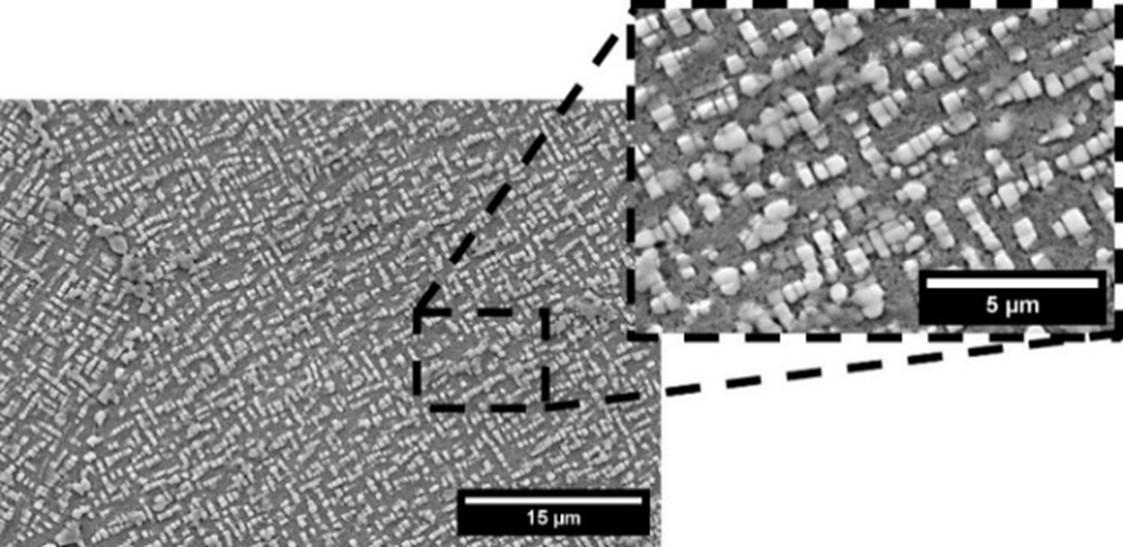
• The size of γ’ was almost constant among the different SA conditions: 239+/-114nm at 1230°C, 283+/-133nm at 1245°C and 264+/-109nm at 1260°C. A similar result was obtained for the γ’ volume fraction, which was 20.4+/-0.5%, 22.3+/-1.1% and 21.4+/-4.2% after SA at 1230°C, 1245°C and 1260°C, respectively.
• Reasonably, when a proper γ’ dissolution is reached, the nuclei formed after the cooling from the SA grow in the same manner during the FA and the cuboidal shape is obtained. Instead, if the SA temperature is too low, an irregular shape is maintained also during the FA.
• After SA at 1230°C, grains were elongated along the building direction, while SA temperatures of 1245°C and 1260°C progressively led to more equiaxial and recrystallized grains. Grains’ aspect ratio decreased from 3,0 (SA at 1230°C) to 1,5 and 1,3 (SA at 1245°C
and 1260°C, respectively).
• Given the abovementioned results, the following recipe for heat treatment of PBF-LB René 80 alloy is proposed: SA at 1260°C for 2 hours + FA at 1095°C for 4 hours. The robustness of the process was investigated heat-treating one sample at 10°C above the optimal SA temperature and neither thermal induced porosities (TIPs) nor incipient melting were observed.
This study provides evidence that the typical heat treatments conditions shall be reconsidered when it comes to AM microstructures. Further studies will focus on assessing the effect of Hot Isostatic Pressing (HIP) on the densification flaws and merging HIP and SA treatment to further optimize the total cycle time.
ACKNOWLEDGEMENT
This conference communication is part of the project NODES which has received funding from the MUR – M4C2 1.5 of PNRR with grant agreement no. ECS00000036.
Scientific papers - Heat Treatment
REFERENCES
[1] Shirani Bidabadi MH, Yu Z, Rehman A, He JG, Zhang C, Chen H, et al. High-Temperature Oxidation Behavior of CrMoV, F91 and Mar-M247 Superalloys Exposed to Laboratory Air at 550 °C. Oxid Met [Internet]. 2018;90(3–4):401–19. Available from: https://doi. org/10.1007/s11085-018-9839-4
[2] Donachie MJ, Donachie SJ. Superalloys: A technical Guide. Vol. 36. 2002. 405–479 p.
[3] Martelli PA, Sivo A, Calignano F, Bassini E, Biamino S, Ugues D. Parameters Optimization and Repeatability Study on Low-Weldable Nickel-Based Superalloy René 80 Processed via Laser Powder–Bed Fusion (L-PBF). Metals (Basel). 2023;13.
[4] Qiu C, Wu X, Mei J, Andrews P, Voice W. Influence of heat treatment on microstructure and tensile behavior of a hot isostatically pressed nickel-based superalloy. J Alloys Compd [Internet]. 2013;578:454–64. Available from: http://dx.doi.org/10.1016/j.jallcom.2013.06.045
[5] Attallah MM, Jennings R, Wang X, Carter LN. Additive manufacturing of Ni-based superalloys: The outstanding issues. MRS Bull. 2016;41(10):758–64.
[6] Safari J, Nategh S. On the heat treatment of Rene-80 nickel-base superalloy. J Mater Process Technol. 2006;176(1–3):240–50.
STAMPI
Il Master nasce con l’intenzione di fornire le conoscenze più aggiornate per la progettazione degli stampi da pressocolata ed è rivolto a tecnici che operano nel settore della progettazione, realizzazione e utilizzo di stampi da pressocolata.
Poiché lo stampo riveste un ruolo decisivo per il risultato economico della fonderia, il Centro di Studio Pressocolata ha voluto dare un contributo decisivo in questa direzione proponendo questo Master. Gli argomenti trattati rappresentano, ad oggi, conoscenze che sono solitamente patrimonio di poche persone e non sempre degli addetti all’ufficio tecnico delle fonderie.
Il Master, pur mantenendo ampio spazio per le esercitazioni pratiche, in cui i partecipanti stessi saranno chiamati a confrontarsi direttamente nella progettazione delle varie componenti stampo, si propone di dare rilevanza a temi estremamente specifici, ma essenziali per le tecnologie di pressocolata più avanzate.
Il Master ripercorre tutte le fasi fondamentali della genesi di uno stampo e delle sue attrezzature: dall’analisi di colabilità del prodotto richiesto e di fattibilità dello stampo al suo abbinamento ideale con la pressa; dall’analisi delle criticità d’usura del sistema pistone-contenitore, fino allo studio dei materiali e sistemi di lubrifica per ottimizzare la vita e l’efficienza del sistema di iniezione, vista anche come possibilità di evitare inneschi di difetti trasferibili al getto finale.
Vengono inoltre approfonditi aspetti legati alla vita dello stampo stesso e dei suoi componenti. Partendo dai criteri di scelta delle diverse tipologie di acciaio e trattamenti termici/termochimici, in funzione delle specifiche lavorazioni e condizioni d’esercizio, si procede fino all’analisi dei difetti nei getti pressocolati anche tramite esercitazioni di laboratorio. Saranno trattati gli aspetti della tecnologia del vuoto applicata alla pressocolata insieme alle più recenti metodologie di progettazione, realizzazione e sensoristica on-process di controllo per tale tecnologia, imprescindibile per molteplici getti a elevate prestazioni.
Il Master si sviluppa su più date suddivise per aree tematiche che ripercorrono quasi idealmente il flusso del metallo in fase di colata, e vuole dare tutti gli elementi tecnici per formare personale in grado di seguire l’intero processo di progettazione di uno stampo e delle sue attrezzature, fornendo sia basi teoriche che pratiche tramite quattro diverse giornate di esercitazioni su casi pratici seguiti nel loro intero sviluppo.
Su www.aimnet.it è possibile scaricare il programma completo dei primi tre moduli.
Date degli incontri:
MODULO 0 (in presenza a Travagliato/Bedizole)
MODULO 1 (da remoto su Zoom)
MODULO 1 (da remoto su Zoom)
MODULO 1 (in presenza a Brescia)
MODULO 2 (da remoto su Zoom)
MODULO 2 (da remoto su Zoom)
MODULO 2 (in presenza a Brescia)
MODULO 3 (da remoto su Zoom)
MODULO 3 (da remoto su Zoom)
MODULO 3 (in presenza a Vicenza)
Coordinatori del Master:
Angelo Citterio - TG Stampi
Alessandro Garlet - Edim
Roberto Martina - Diecasting Service

Giulio Timelli - Università di Padova, sede di Vicenza
Evento patrocinato da
Segreteria organizzativa
Via F. Turati, 8 20121 Milano Tel. +39 0276397770
e-mail: spedizioni@aimnet.it aim@aimnet.it www.aimnet.it
L'arte involontaria
Un fabbro utilizza regolarmente una troncatrice abrasiva per tagliare i pezzi per il suo lavoro. I trucioli incandescenti vengono guidati dallo schermo di protezione e si aggregano uno sull’altro con una parziale saldatura causata dall'alta temperatura. Ogni 2-3 anni il fabbro pulisce la macchina estraendo queste “sculture”.
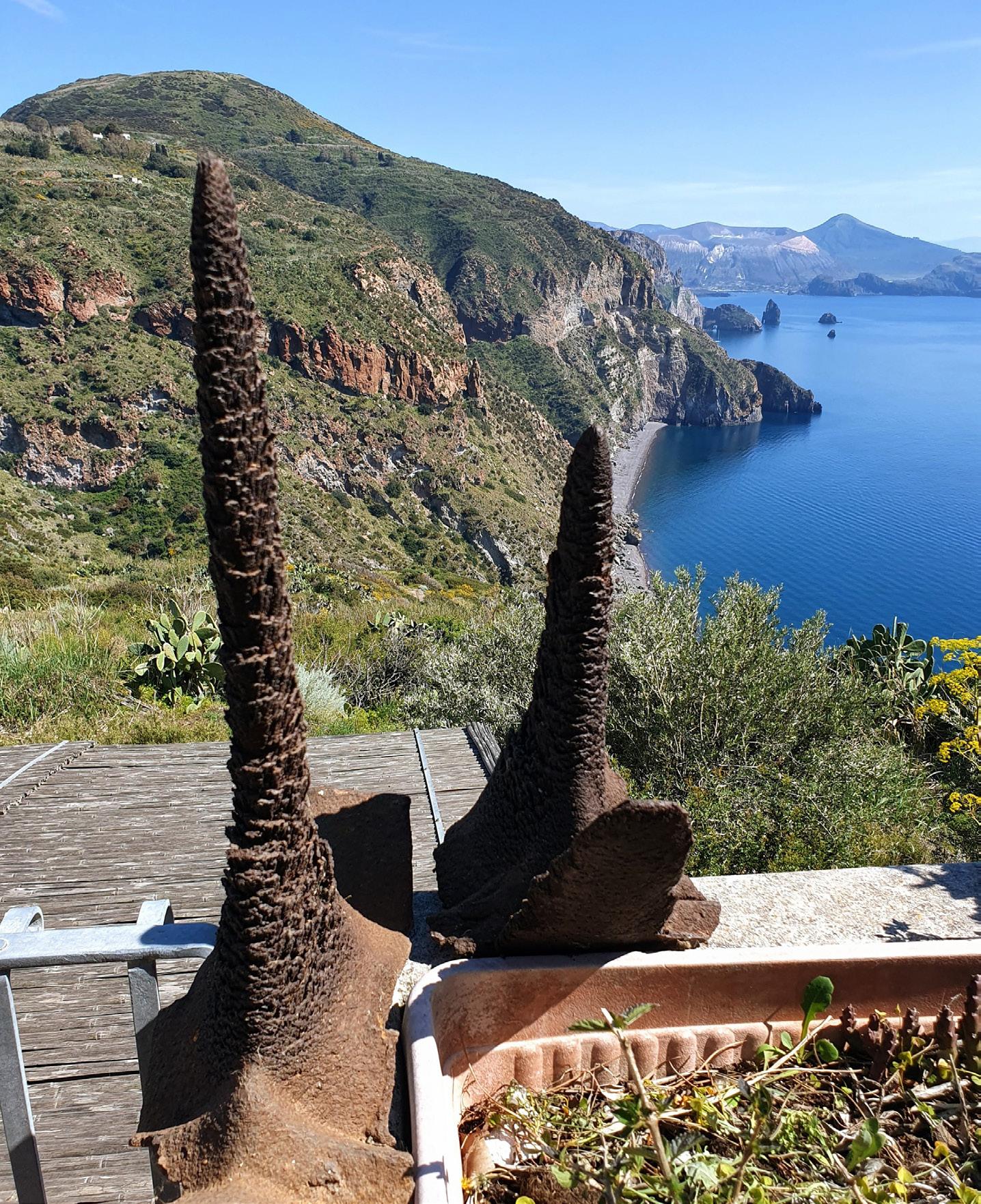
Oxide scale modelling on low carbon steels: kinetics characterization and failure prediction during hot-deformation processes
edited by: M. Moreno, P. LasnesOxide scale growth kinetics were studied during heat treatments (up to 60 min) of low carbon steels (C22,C45, 34CrMo4 and 42CrMo4) in the typical hot-forging temperature range for steels (from 950 to 1200°C).Heat treatments were carried out using gas and electric furnaces to study the influence of the oxidizingatmosphere on the growth kinetics and evaluate the relevance of published data established under ideallaboratory conditions. The oxide scales are constituted of layers of wüstite, magnetite and hematite. Oxidephase fractions are impacted by the utilized type of furnace. Oxidation kinetics are few sensitive to the steelgrade. Regarding the utilized furnace, kinetics is very similar except when treatment time exceeds 40 min fortemperatures higher than 1100°C. Kinetics constants were calibrated on data. Oxide scale failures werestudied during hot forging by coupling AI assisted Image Analysis and FEM software FORGE® to estimatesuperficial critical failure strains. The adherence energy of oxide layers has been modelled and implementedinto a failure criterion from literature. The maximal calculated adherence of oxide layers reaches 860J.m-2.
KEYWORDS: OXIDATION KINETICS CONSTANTS, FEM MODELING, LOW CARBON STEELS, HOT-FORGING, OXIDE SCALE FAILURE, FORGE SOFTWARE, INDUSTRIAL FURNACE
INTRODUCTION
Oxidation kinetics characterization and modelling activities are carried out since decades, and continue to receive great attention so far, especially in field of hot rolling [1]. This is justified by the need in improvement for the predictability of oxidation to optimize processes efficiency, minimize material wasting and gain in cost effectiveness. Steel calamine impacts the surface properties by modifying thermal and contact properties.
In literature, authors track different objectives, namely the influence of water steam, carbon-monoxide, carbon-dioxide, oxygen, etc, using controlled atmospheres which do not reflect the industrial environments. Moreover, even though studies are carried out at elevated temperatures, sometimes the studied experimental temperature range is not suitable regarding the hot forging temperatures used in practice. Then, the motivation of current work is to characterize and model oxidation kinetics and also failure in industrial condition to discuss the relevance of published data. Subjacent objective is to implement these models in finite element simulation software (FORGE®) to permit the users to evaluate the mass of wasted material due to oxidation.
MATERIALS AND EXPERIMENTAL PROCEDURE
Four steel grades where studied. Table 1 details the simplified nominal compositions. Low carbon C22 and C45 specimen, 100 mm long were cut down from long bars diameter 70 mm. The microalloyed 34CrMo4 and
Tab.1
Heat treatment procedure, oxidation kinetics and oxide scale growth and failure investigations
Three temperatures were investigated: 950, 1150 and 1200°C for 30, 45 and 60 min holding to characterize oxidation kinetics in gas or electric furnace. Oxide scale layers constitution and compositions were observed by means of optical and Scanning Electron Microscopy (SEM, BSC mode) and X-Ray diffractions (XRD). The mass of oxide formed during thermal holdings was estimated by weighing mass differences before and after oxide descaling (shot peening). Oxide scale failure was studied by capturing hot-deformation processes using a 25-fps


42CrMo4 specimens, 120 mm long were cut down from bars of diameter 80 mm to keep samples to a constant height / diameter ratio.
camera. Associating Image exploitation with the Finite Element (FEM) simulation software FORGE® enables to relate the failure events with effective mechanical deformation and strain rates.
OXIDE SCALE CONSTITUTIONS
Figure 1(a-b) shows the achieved oxide layer crosssections obtained after treatment in gas and electric furnace, respectively. Oxide consists in stacked layers of wüstite (FeO, first layer), magnetite (Fe2O3, intermediate layer) and hematite (Fe3O4, top thin bright layer)).
The nature of oxide scale has revealed to be dependent on the utilized type of furnace since scales on gas furnace are essentially made of wüstite (90%mass). The oxide mix is
more balanced for oxides formed in the electric furnace. Table 2 summarizes the scales constitutions measured using XRD.
Tab.2 - Quantified oxide constituents mass fraction (XRD) after oxidation in gas and electric furnaces.

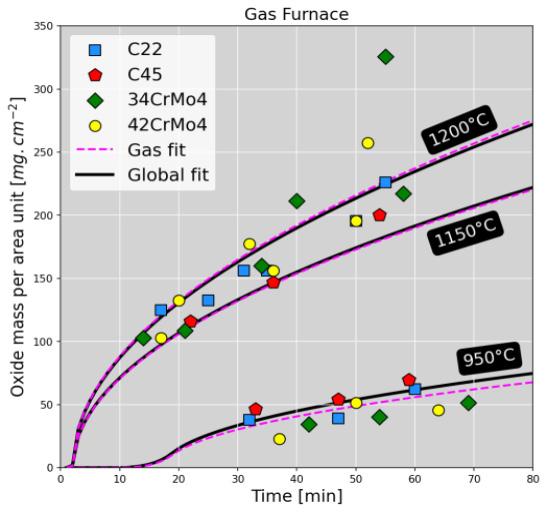
OXIDATION KINETICS CHARACTERIZATION AND MODELLLING
The oxidation kinetics is characterized by the evolution
of the surface oxide density (mg.cm-2). The oxide mass is modelled using the Wagner’s method [2], detailed in expression (1): (1)
where A is the surface area unit (cm2), ∆�� the mass weighed mass difference (g) between unoxidized / cleaned oxidized samples, t the holding time (sec) and K p the kinetics constant (g².cm-4.s-1). Kp is modelled with an Arrhenius function where f is the pre-exponential factor, Q the activation enthalpy (J.mol-1). R the ideal gas constant

(J.mol-1.K-1) and T the temperature (K). Current calibration is very consistent with data from literature [3]. Figure 2 displays the measurements (dots) as well as the oxidation kinetics predicted using the calibrated model (continuous lines).
Kinetics follow a typical parabolic trend, consistently with diffusion-controlled mechanisms (oxygen and iron cations). Even though oxide scale constitution is dependent on the furnace atmosphere, oxidation kinetics
is few sensitive to the steel grade. Kinetics are very similar between both furnaces, but for temperatures higher than 1100°C in the electric furnace, a slowdown occurs after 40 min holding, no matter the studied steel. The observed
kinetics slowdown is caused by a transition from wüstite to magnetite growth in which chemical components diffuse mush slower. This transition is promoted in electric furnace because the concentration in dioxygen is higher than is gas furnace where combustion consumes dioxygen and produces carbon /monoxide dioxide.
OXIDE SCALE FAILURE IDENTIFICATION AND OXIDE ADHERENCE DETERMINATION
Image captured during sample hot forging (compression) were treated to follow the sample height as function of time. This yields to the experimental forging schedule which was reproduced in the FEM simulation software FORGE® to estimate the deformation rate and the strain
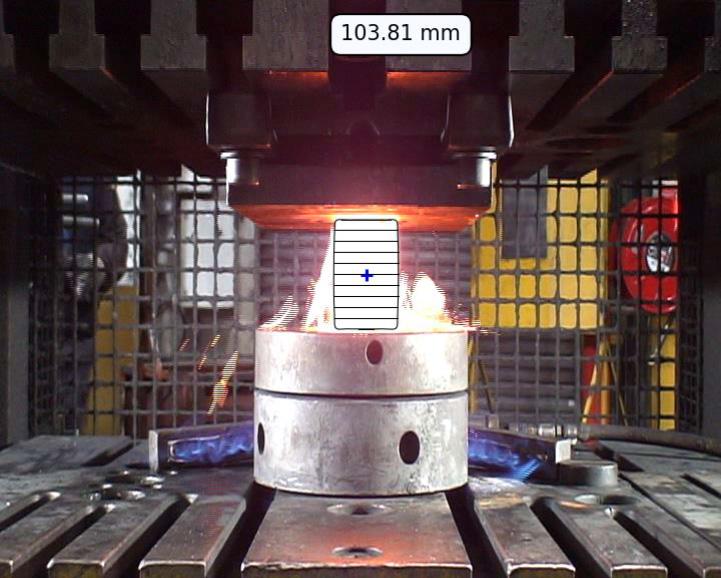
anywhere on the sample surface. The locations where failures occurred have been inventoried. For this purpose, AI tools have been developed to help at identifying the true billet contours and better estimate the failure locations (Fig.3a). Once the locations are identified, it is possible to relate the failure location with its local deformation state as well as the associated strain rate by reading the simulation results at the same instant. Knowing the average scale thickness for each experiment, adhesion energy γ0 (J.m2) of oxide layer has been calculated using the method proposed by [4]. The adhesion energy is hence dependent on strain rate, temperature, and scale thickness. Figure 3b reports the distribution of calculated adhesion energies γ0 for all performed experiments.
The estimated adhesion energies γ0 are in very good agreement with respect to data published by [4]. The adhesion energy ��0 has been implemented in the failure
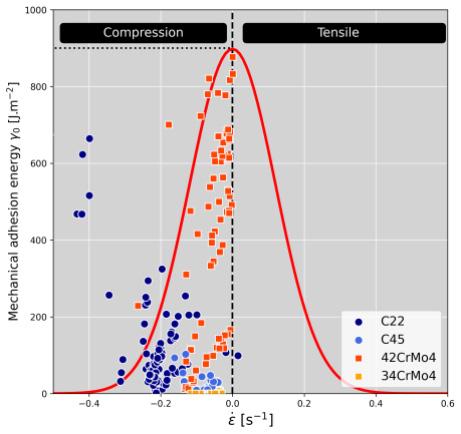
criteria proposed by [5]. This criterion is actually a critical strain εc. Hence, the failure criterion has been improved since its now takes into account the strain rate.
where γ0 is the oxide layer adhesion energy (J.m-2), d the oxide scale thickness (m), E the Young’s modulus (N.m-2) and ν the Poisson ratio.
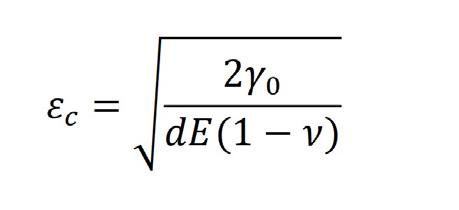
APPLICATION IN SIMULATION FOR OXIDE GROWTH AND FAILURE
Latter investigations have conducted to the design of a new functionality in the simulation software FORGE®
to permit the prediction of the oxide mass density and the mass balance of wasted material along hot forging processes. The current example in Figure 4 simulates an industrial reference case where an initial cylindric billet (to about 16 kg) is hammered (10 hits) using a 300 kg hammer. Latter investigations were utilized to build a prediction functionality combining oxide growth and failure when the critical strain is achieved. In fig.4b, the evolution of
the averaged surface oxide mass density shows alternated growth – failures (blue curve) relative to the hammer hits.
(a) (b)
Fig.4 - (a) FEM simulation of hammer process (10 hits) using the FEM simulation software FORGE®. (b) Cumulated material loss due to oxidation after each hammer hit (red curve) and oxide formation kinetics between hits (red curve).
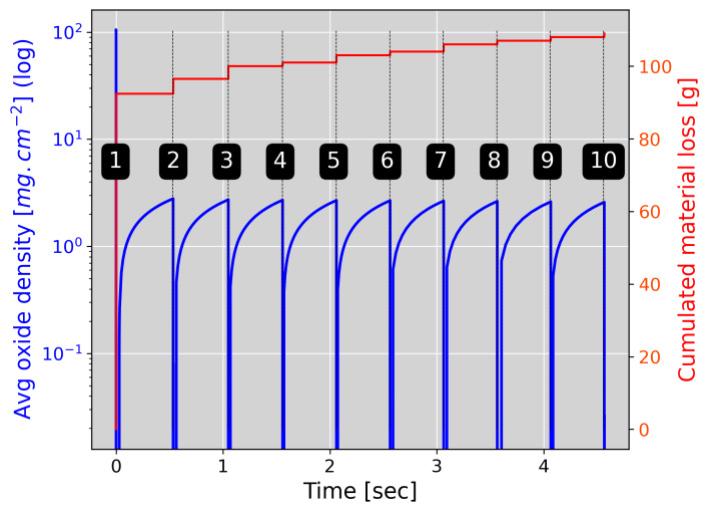
CONCLUSION
Oxidation kinetics of low carbon steels have been characterized in the 950 - 1200°C typical hot-forging temperature range and for times up to 60 min. This investigation includes kinetics measurements by means of microscopy, XRD and oxide weighing. Different industrial atmospheres in gas and electric furnaces were studied to verify the relevance of published laboratory data. No significant kinetics gap is observed except for holding
times longer than 40 minutes in the electric furnace, because the nature of the growing oxide is changing. In addition, adhesion energy of oxide layers has been estimated and is found dependent on the temperature and the strain rate. The maximal estimated adhesion energy achieves 860 J.m-2. These investigations have permitted to optimize an existing oxide failure criterion (critical strain) proposed in literature.
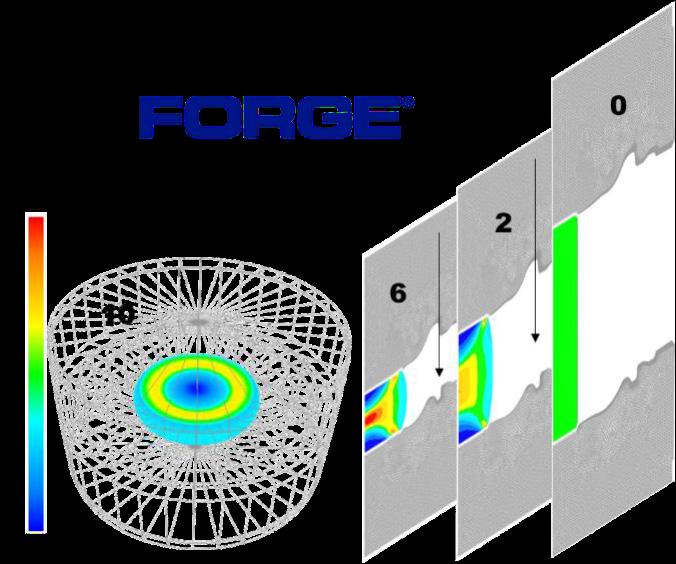
BIBLIOGRAFIA
[1] Sun W, Tieu AK, Jiang Z, Lu C. High temperature oxide scale characteristics of low carbon steel in hot rolling. Journal of Materials Processing Technology. Nov 2004;155-156:1307-12.
[2] Wagner C. Equations for transport in solid oxides and sulfides of transition metals. Progress in Solid State Chemistry. 1975;10:3-16.
[3] Chen RY, Yuen WYD. Review of the High-Temperature Oxidation of Iron and Carbon Steels in Air or Oxygen.
[4] Schütze M. Mechanical properties of oxide scales. Oxid Met. August 1995;44(1-2):29-61.
[5] Chandra-ambhorn S, Klubvihok N. Quantification of Adherence of Thermal Oxide Scale on Low Carbon Steel Using Tensile Test. Oxid Met. Febr 2016;85(1-2):103-25.
TORNA ALL'INDICE >
Controllo del processo ed efficienza energetica nella forgiatura mediante simulazione
Le sfide dell'industria della forgiatura nel futuro
Negli ultimi anni, l'industria della forgiatura sta affrontando nuove sfide. La forte pressione competitiva dei concorrenti internazionali sul mercato dei grandi forgiati (ad esempio, alberi di generatori e turbine) ha portato ad un numero sempre maggiore di ordini verso forgiatori esteri in particolare per i componenti critici in termini di sicurezza e questa tendenza continua. I concorrenti stranieri riescono ad essere più competitivi, grazie a
costi inferiori dell'energia (elettricità per le presse, gas naturale per i forni di riscaldo e trattamento termico), del personale e per le normative ambientali meno stringenti. Nel settore dell'approvvigionamento energetico, la situazione della forgiatura si è recentemente notevolmente deteriorata in Europa. Anche a causa del conflitto in Ucraina, il prezzo dell'elettricità in Italia ha subito bruschi aumenti negli ultimi 3 anni (con picchi fino a circa 530 EUR/MWh ad agosto 2022). L'aumento dei costi di
fornitura dell'energia elettrica ha un impatto diretto sui costi di produzione e danneggia i produttori italiani rispetto alla concorrenza internazionale.
Tecnologie alternative per i forni di riscaldo (ad esempio idrogeno o riscaldamento elettrico) non sono attualmente disponibili poiché i forni alimentati a H2 sono ancora in fase di sviluppo e i sistemi elettrici sono inefficaci e non consentono determinati tipi di trattamento termico.
Pertanto, l'industria della forgiatura si trova di fronte alle seguenti sfide:
• risparmio energetico in produzione (riduzione dei consumi di gas ed elettricità)
• riduzione delle emissioni di CO2
• sviluppo di sequenze di forgiatura più efficienti
• aumento della resa per lingotto
• riduzione degli scarti (aumento della qualità del prodotto)
Come aumentare la competitività
Per rispondere alle criticità menzionate, l’ingegneria di produzione e la Qualità possono applicare diverse metodologie:
• riduzioni sul consumo di gas nei forni di riscaldo e trattamento termico, mediante un’oculata gestione dei cicli termici, ad esempio sfuttando il calore residuo di solidificazione, ottimizzando le permanenze in

forno e l’evoluzione dei profili termici locali sui componenti da trattare)
• sviluppo di sequenze di forgiatura più efficienti, riducendo il più possibile il numero di fasi di processo ottimizzando la distribuzione della deformazione sull’intero ciclo, assicurando la chiusura delle porosità, il rispetto del tonnellaggio massimo delle presse ed evitando al contempo surriscaldamenti del componente in deformazione e livelli di tensione eccessivi nel materiale
• aumento della resa per lingotto, mediante ottimizzazione della distribuzione di materiale e delle sue caratteristiche microstrutturali e riduzione/eliminazione delle zone a rischio di scarto (cricche, porosità, ecc.)
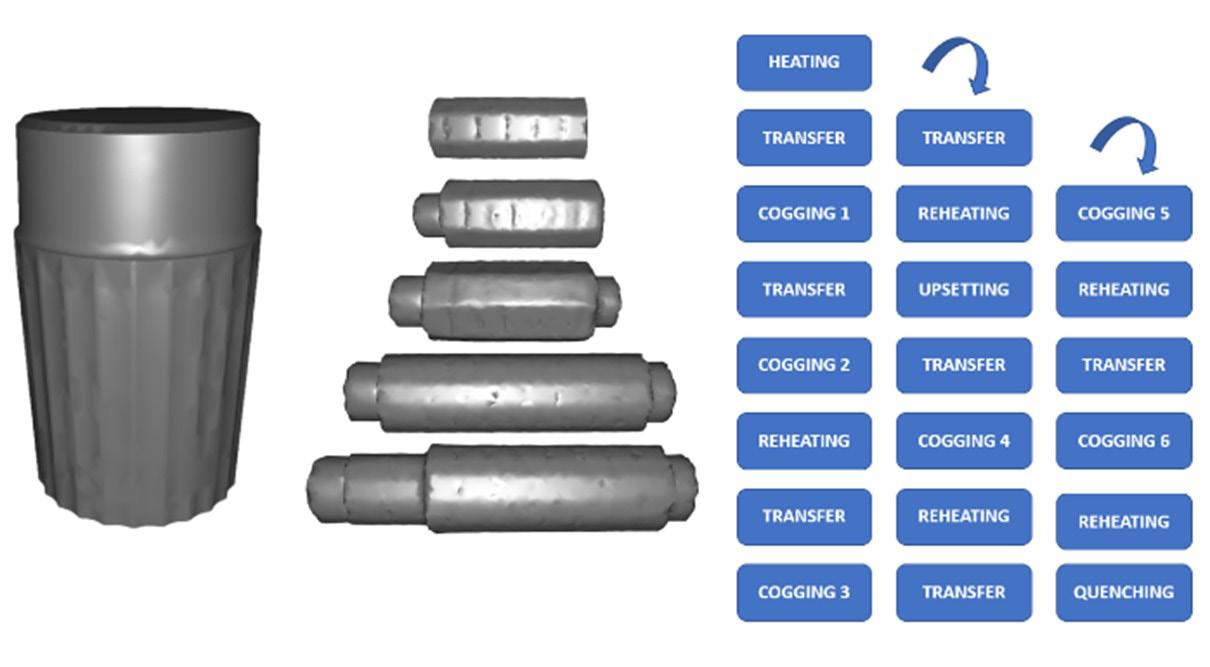
Simulazione del processo di colata e forgiatura di lingotti: strumenti essenziali per ottimizzare il processo In mercati competitivi e in continua evoluzione, gli strumenti di simulazione di processo sono divenuti essenziali per il ciclo di sviluppo di componenti ad alto valore aggiunto in quanto, per controllare la qualità di un prodotto forgiato, è essenziale avere una conoscenza approfondita di tutte le fasi del processo di produzione: colata, forgiatura e trattamento termico. I software di simulazione della colata THERCAST® e della forgiatura a caldo FORGE® consentono un approccio olistico alla progettazione e ottimizzazione del processo. Il software di simulazione della colata THERCAST® è particolarmente utile per simulare il processo di produzione di lingotti di grandi dimensioni. Simulando il riempimento e la solidificazione del me-
tallo, il software calcola la probabilità e la posizione di vuoti o cricche, fondamentale per garantire la qualità dei lingotti che verranno utilizzati nella produzione di forgiati. Questi risultati possono essere poi trasferiti alla simulazione di forgiatura in modo automatico, grazie all'interoperabilità delle soluzioni Transvalor.
Relativamente alla parte termica, il software permette di studiare il trasporto del lingotto colato e il suo riscaldo in forno nella fase iniziale e nelle fasi di ricaldo intermedie, al fine di ottimizzare i tempi di riscaldo e massimizzare il risparmio energetico. L'esempio mostrato nella Figura 2 mostra una sequenza completa di forgiatura che può essere simulata, comprese le fasi di riscaldo, trasferimento e tempra finale.
I modelli utilizzati per prevedere la chiusura della porosità stimano l'evoluzione del volume di porosità in fun-
zione della deformazione locale subita durante uno stato di compressione o tensione.
La Figura 3 mostra l’evoluzione della porosità (zone rosse) durante le prime fasi della forgiatura e come questa si riduca gradualmente in funzione della
deformazione applicata. Alla fine del processo di forgiatura, le porosità del materiale sono quasi completamente chiuse. Tuttavia, come riportato in
Un secondo obiettivo della forgiatura è il miglioramento della struttura interna del materiale, in quanto, generalmente, la struttura as-cast (micro e macro) non è compatibile con le caratteristiche finali richieste per il componente. La simulazione consen-
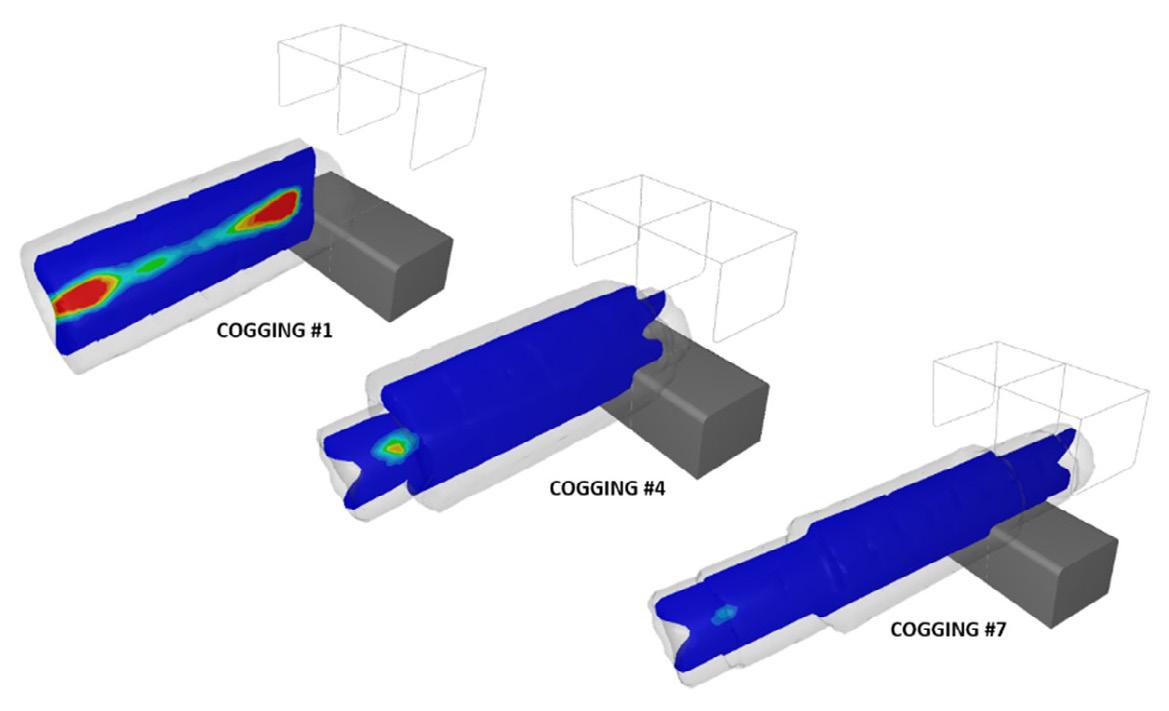
te di modellare i fenomeni di ricristallizzazione che si verificano durante le fasi di formatura, come la ricristallizzazione dinamica, così come durante le fasi di trasferimento o riscaldamento, come la ricristallizzazione statica o metadinamica. La simulazione in Fi-
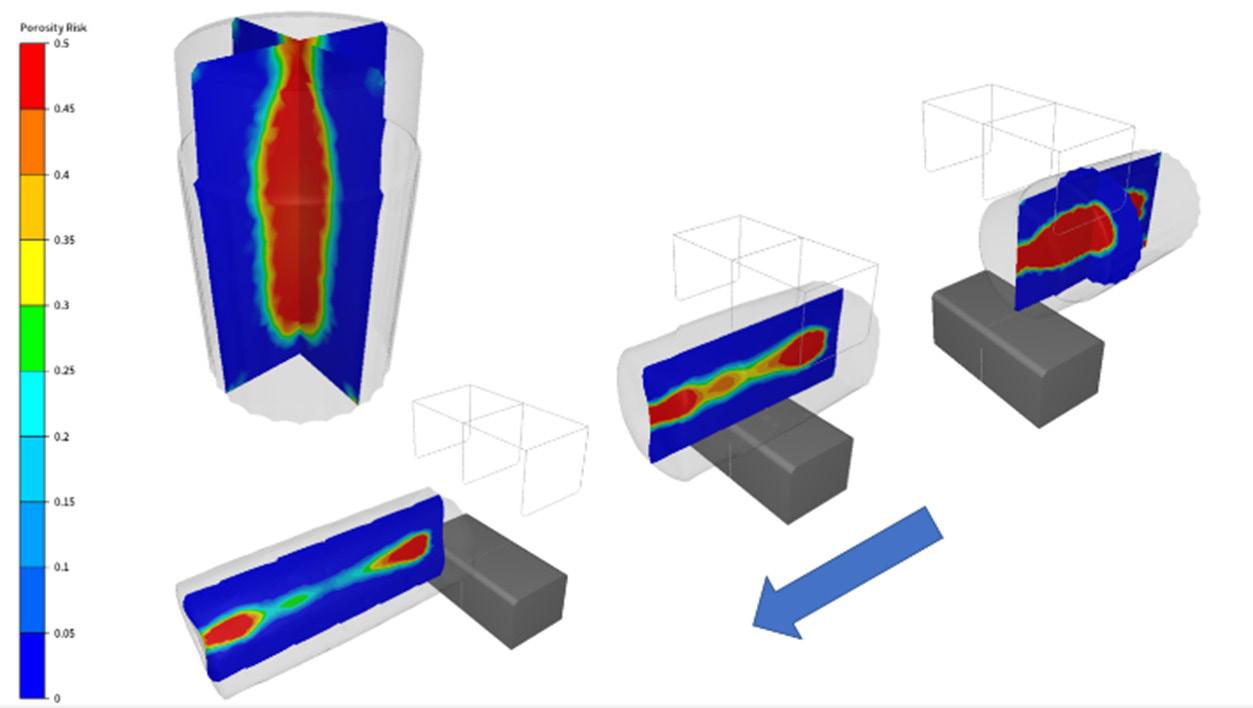
Una volta completato il processo di forgiatura, vi è generalmente una fase di trattamento termico. In questo caso, la simulazione consente di modellare un'ampia varietà di processi di trattamento termico (ad es. tempra, ricottura, rinvenimento, austenitizzazione, ecc.) per analizzare l’evoluzione della temperatura durante il riscaldamento e determinarne quindi la giusta durata. Consente inoltre di testare l'impatto dei diversi mezzi di tempra e il relativo livello di agitazione. È essenziale controllare lo scambio termico tra il pezzo e il mezzo di tempra per evitare difetti come deformazioni e cricche e per ottenere buone proprietà meccaniche, con l’adeguata distribuzione (ad es. controllando la profondità di tempra).
Nuovo modello per simulare l’evoluzione dell’ossido È stato sviluppato un nuovo modello per prevedere lo spessore e la massa
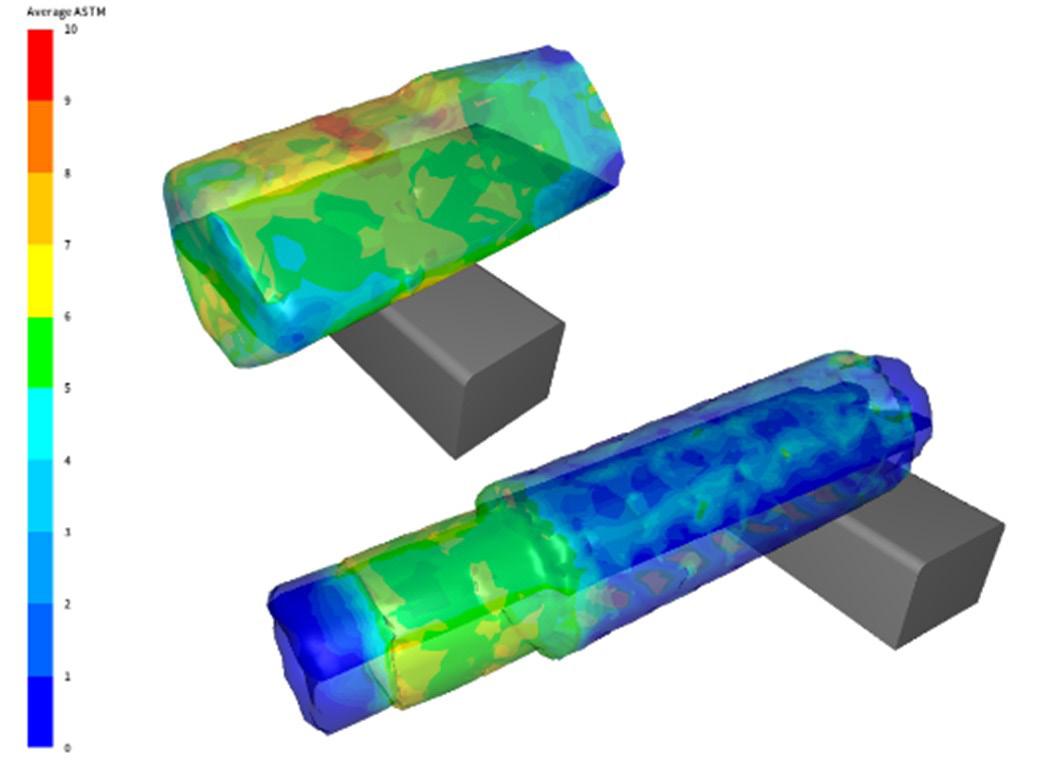
dello strato di ossido superficiale che si forma durante i processi ad alta temperatura. Il modello è applicabile alla crescita dello strato di ossido su ferro puro e acciai bassolegati. Esso comprende due meccanismi di crescita: crescita per diffusione e crescita per assorbimento superficiale. Gli strati di ossido sono composti da tre fasi: wüstite (FeO), magnetite (Fe3O4) ed ematite (Fe2O3). Per temperature inferiori a 900°C, la wüstite è il costituente principale (circa il 95% in volume), che influenza fortemente le proprietà della scaglia. La wüstite è la fase più morbida ed è particolarmente sensibile alla dissoluzione delle specie chimiche a causa dell'elevata presenza di vuoti nel reticolo cristallino del ferro (tra il 5 e il 16%).
Tuttavia, la frazione volumetrica di wüstite può cambiare con la temperatura (stabilità termodinamica) e il tempo (diffusione degli elementi
attraverso lo strato): l'aumento della concentrazione di ossigeno porta alla formazione di wüstite, quindi magnetite e successivamente ematite. In molti casi in cui la temperatura supera i 900°C, la wüstite rimane il principale costituente della scaglia. Per la crescita controllata dalla diffusione dell'ossigeno, lo spessore della scaglia può essere previsto a partire dalla reazione chimica. Un'equazione parabolica viene utilizzata nel software FORGE® per calcolare lo spessore della scaglia (in cm), assumendo uno strato composto al 100% di wüstite:
(Eq.1)

In questa equazione, Qscale è l'entalpia di attivazione in J/mol, valore che
può essere adattato per considerare un'ampia gamma di acciai o atmosfere
di forni (ad esempio basse o alte concentrazioni di CO2).
AIM's companies - Le aziende di AIM
Va notato che le caratterizzazioni sperimentali basate sulla valutazione della perdita di massa sono più accurate. Gli strati di ossido non sono compatti a causa della presenza di diversi difetti come cricche, solchi, porosità o blister. Se questi difetti non vengo-
no presi in considerazione, possono portare a una sovrastima di almeno il 30 % degli spessori di scaglia misurati. Il confronto tra le simulazioni e i dati sperimentali (basati sulla perdita di massa) nella Figura 6 dimostra un buon accordo. Questo confronto evi-
denzia l'affidabilità del modello di crescita dell’ossido per brevi e lunghi periodi. Va notato che, in questo caso, la crescita è solo quella controllata dalla diffusione.
(a)
La figura 7 illustra la crescita della scaglia durante la fase di riscaldo successiva al quarto passo di forgiatura riportato
Monitoraggio e digital twin di processo
Nel contesto della forgiatura, è fondamentale comprendere a fondo l’evoluzione della deformazione e lo stato delle attrezzature di forgiatura.
Questo è il motivo per cui molti OEM e fornitori di software hanno compiuto sforzi per garantire la migliore interoperabilità possibile tra i sistemi di acquisizione in tempo reale e il software di simulazione.
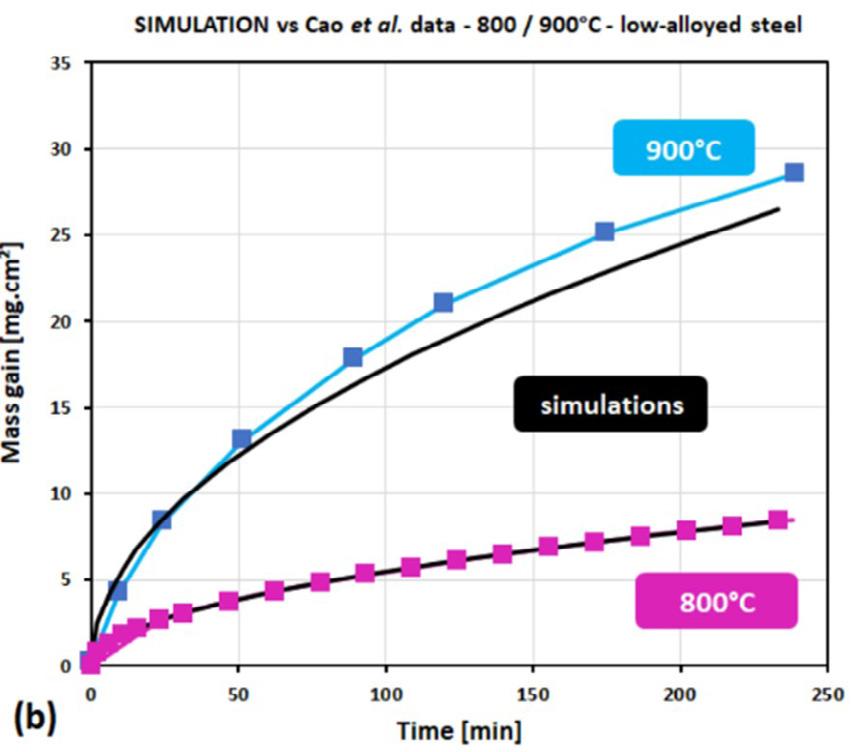
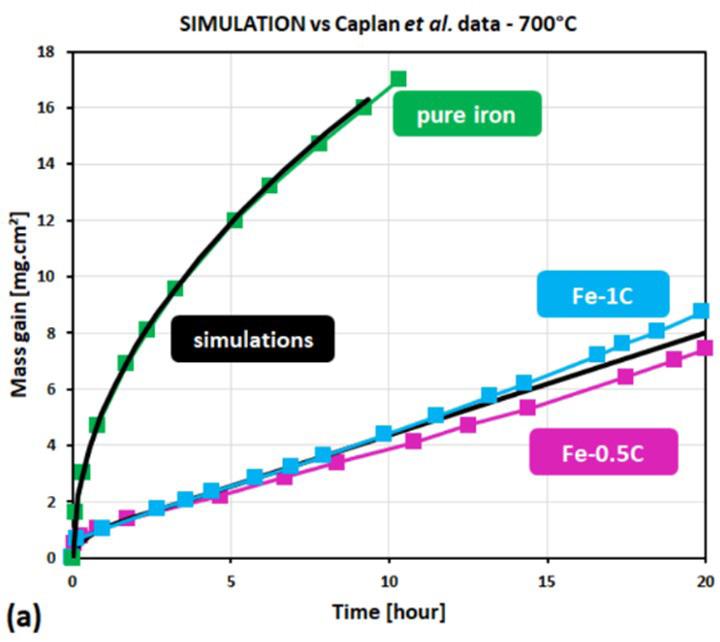
In quest’ottica, sono stati sviluppati sistemi di monitoraggio e registrazione dei parametri di processo che consentono all’operatore di valutare in real-time le condizioni di lavoro. Questi sistemi (ad esempio "LaCam®

Forge") registrano tutti i dati di processo rilevanti (forza di forgiatura, posizione delle mazze e del manipo-
latore, temperatura superficiale, ecc.) e monitorano l’evoluzione dimensionale del componente in lavorazione
mediante sistemi non a contatto (ad esempio sistemi laser).
Grazie all’integrazione con la simulazione FORGE®, è possibile quindi realizzare un vero e proprio digital twin del processo di forgiatura, identificarne i punti deboli, ad esempio in termini di chiusura della porosità e le potenzialità di efficientamento, sia in termini di qualità che di riduzione dei costi, inclusi quelli energetici. Tuttavia, per creare un digital twin della forgiatura che sia efficace per affrontare le sfide descritte, vi sono alcune requisiti essenziali. L’ingegnere di processo che vuole avvalersi della simulazione numerica dei processi di forgiatura e trattamento termico deve conoscerli approfonditamente, oltre ad avere buone basi della scienza dei materiali e una certa esperienza nell'analisi dei dati assistita da computer. È essenziale avere accesso ai dati di misura affidabili, come le temperature superficiali dei forgiati (misurate mediante pirometria o termografia), le forze di forgiatura e la cinematica (ad esempio i dati di controllo della pressa e del manipolatore), così come le temperature dei forni di riscaldo e trattamento termico.
Questi dati sono importanti per la creazione di modelli agli elementi finiti realistici e possono anche essere utilizzati per confrontare e calibrare modelli con dati "reali". Questo modello, calibrato con dati reali, consente quindi l'analisi dei processi di forgiatura esistenti o offre la possibilità che nuove sequenze possano essere realizzate e analizzate nella "fucina virtuale" al minor costo.
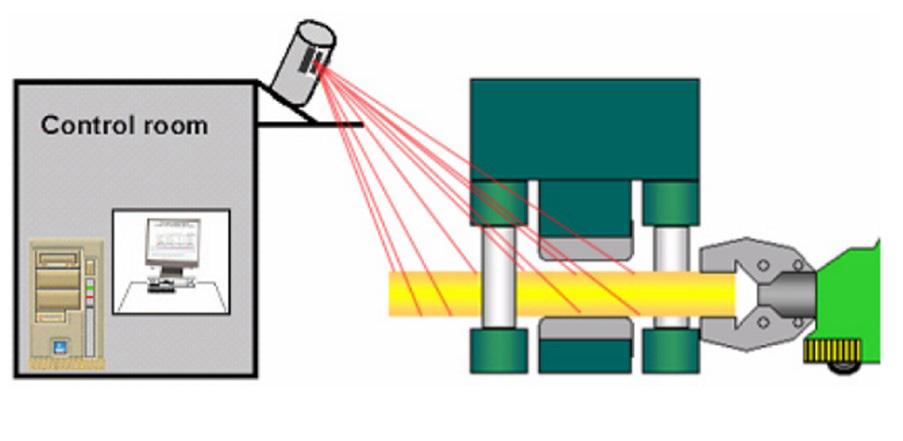
Conclusioni e prospettive Di fronte alle sfide odierne, l'industria della forgiatura deve adattare rapidamente la propria ingegneria per soddisfare gli obiettivi ecologici dettati dal riscaldamento globale e reagire all'improvviso aumento dei costi energetici.
Questo articolo dimostra come strumenti di simulazione numerica efficienti forniscano un aiuto concreto per superare queste sfide, supportando gli ingegneri nella realizzazione di processi di colata e forgiatura innovativi e ambiziosi che permettano risparmi di materiale, una maggiore qualità dei prodotti e un efficienta-
mento energetico.
La produzione virtuale dimostra la sua utilità aumentando la qualità dei prodotti in molti aspetti:
• resa del lingotto migliorata
• minimizzazione di porosità e di fasi indesiderate
• ottimizzazione dei tempi di riscaldo
• analisi dell’effetto degli strati di ossido
Inoltre, il software di simulazione interagisce perfettamente con la tecnologia di misura in tempo reale (LaCam® Forge) che descrive accuratamente il comportamento di parti e stampi nella pratica operativa. La combinazione intelligente di un software di simulazione all'avanguardia con un moderno sistema di misura dà all'industria siderurgica un notevole contributo oggi per migliorare la produttività, e in futuro per applicazioni più ambiziose basate su tecnologie digital twin.



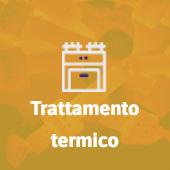
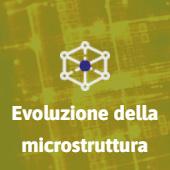



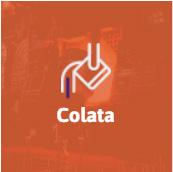
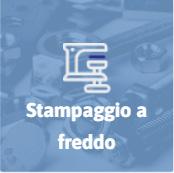
Acciaio e metalli: dinamiche, cicli e tendenze di mercato
Rubrica trimestrale a cura di Achille FornasiniHa insegnato all’Università Bocconi di Milano, all’Università di Venezia e all’Università di Brescia, dove è responsabile del Laboratorio per lo studio delle Dinamiche dei Sistemi e dei Mercati finanziari. Coordina l’osservatorio congiunturale di Confindustria Brescia e di ANIMA Confindustria. Partner di Sidewerb, da vent’anni cura rubriche dedicate ai mercati siderurgici e metallurgici. È autore di libri e centinaia di saggi, editoriali e articoli su temi economico-finanziari.
Dopo i primi due contributi dedicati alla siderurgia pubblicati nei numeri di febbraio (pagg. 91-94) e di maggio (pagg. 60-63) de La Metallurgia Italiana, con questo nuovo appuntamento della rubrica affrontiamo le dinamiche dei prezzi dei metalli non ferrosi e delle ferroleghe. Come di consueto, prima di approfondire gli andamenti di mercato è utile considerare come si sia evoluta nel frattempo la congiuntura economica.
Il contesto generale
Le stime di giugno dell’Ocse confermano le prospettive delineate in aprile: gli Stati Uniti sono attesi in bassa crescita nel 2023 (+1,6%), che dovrebbe rallentare all’1% nel 2024 a causa delle ricadute della politica monetaria restrittiva intrapresa nel 2022 dalla Federal Reserve. La Cina dovrebbe registrare una crescita più consistente quest’anno (+5,4%) e in frenata nel 2024 (+5,1%), mentre in Eurolandia si prevede un PIL dello 0,9% nel 2023 e dell’1,5% l’anno prossimo. Come già anticipato nelle analisi precedenti, il rallentamento dell’economia globale dipende essenzialmente da tre fattori: in primo luogo la persistenza del conflitto russo-ucraino, che costituisce motivo di incertezza permanente; secondariamente la crescita meno forte del previsto della Cina, che sta pagando gli effetti di una progressiva contrazione dell’interscambio con l’estero, e infine l’inflazione che secondo l’Ocse è destinata a calare dal 9,4% del 2022 al 6,6% nel 2023 e al 4,3% nel 2024 grazie alle manovre monetarie restrittive, al ridimensionamento dei costi

energetici e alla riduzione delle strozzature dell’offerta. Nella corrente fase storica, peraltro, i tassi d’interesse sempre più elevati imposti dalla necessità di contenere l’inflazione da parte delle banche centrali hanno già iniziato a produrre ricadute negative sull’operatività delle imprese, insidiando inoltre le vulnerabilità finanziarie dei Paesi fortemente indebitati come il nostro. In Italia l'elevata inflazione sta erodendo i redditi reali, le condizioni finanziarie si stanno inasprendo e i ritardi nell'attuazione del Piano Nazionale di Ripresa e Resilienza potrebbero rallentare la crescita del PIL. Secondo l’Istat, inoltre, nel biennio 2023-24 la crescita sarebbe meno sostenuta dal contributo delle esportazioni a causa della recessione tecnica già vigente in Germania, nostro principale partner comemrciale, e della frenata dell’economia Usa: fenomeno accentuato dal corrente apprezzamento dell’euro, che limita la competitività del nostro export diretto verso l’area del dollaro.
I metalli non ferrosi
Nell’ambito di uno scenario globale tendente alla stagnazione, la progressiva contrazione della domanda di materie prime trova conferma nella figura 1, che illustra l’andamento medio settimanale dell’indice LMEX: indicatore che sintetizza i prezzi di sei metalli non ferrosi - alluminio, rame, piombo, nickel, stagno e zinco - quotati al London Metal Exchange, la borsa fondata a Londra nel 1876 per favorire gli scambi a pronti e a termine attraverso modalità e strumenti orientati all’investimen-
Steel and metals: market dynamics, cycles and trends
to, alla copertura di posizioni e alla mera speculazione finanziaria. Più in particolare, il parametro rappresenta la misura complessiva dei prezzi dei sei metalli, ciascuno di essi ponderato in funzione della produzione globale e della liquidità mediamente generata nel quinquennio precedente. All’ordinata di destra del grafico sono riferiti i livelli dell’indice, mentre l’ordinata di sinistra richiama la scala dell’istogramma che segnala l’entità complessiva dei depositi dei sei metalli presso i magazzini ufficiali del mercato londinese, cioè la misura dell’effettiva disponibilità di materiale fisico pronto alla consegna. Osservando la figura, si evidenziano tre movimenti principali: il primo (+135,3%) si sviluppa dai minimi toccati a fine marzo 2020, a causa degli effetti dei precedenti lockdown della prima fase pandemica, fino alla seconda settimana di marzo del 2022 quando si esaurisce la spiccata fase espansiva susseguente ai rigori imposti dalla pandemia da Covid-19. Il secondo movimento si dipana invece al ribasso fino a settembre dello scorso anno (-34,7%) per cause riconducibili principalmente al calo progressivo della domanda di metalli a fini produttivi da parte degli utilizzatori. Segue un moderato recupero (+24,8%), che si esaurisce alla fine del mese di gennaio di quest’anno,
quando prende corpo una nuova flessione, che mantiene peraltro i livelli dell’indice al di sopra dei minimi registrati nel settembre scorso. Si tratta dunque di un generale assestamento della curva dell’indice nell’ambito di un ideale corridoio stazionario i cui limiti sono definiti dai minimi e dai massimi già indicati. A completamento dell’analisi, si noti come le giacenze presso i magazzini del mercato londinese abbiano iniziato a diminuire sistematicamente dal mese di marzo 2021, quando le forze della domanda hanno preso il definitivo sopravvento su quelle dell’offerta: l’abbassamento delle scorte si è arrestato nel mese di settembre dello scorso anno con un esito storicamente significativo (-79,1%). Successivamente le provviste dei metalli presso i magazzini del mercato londinese tornano a ricostituirsi, incrementando fino alla data di questa pubblicazione (+31,7%).
Le performance dei singoli metalli ripropongono ovviamente, con differenze anche significative tra di essi, quelle dell’indice sopra segnalate: lo prova la tabella 1, che riporta gli esiti di ciascun metallo nelle tre fasi di mercato già commentate a proposito del loro indice generale, alle quali si aggiungono gli esiti correnti e le immediate prospettive evolutive.
Un ulteriore aspetto è destinato a condizionare l’andamento dei prezzi dei metalli non ferrosi quotati a Londra, essendo essi quotati in dollari: la contestuale dinamica dei rapporti di cambio tra il dollaro e le altre principali valute. Il rafforzamento della divisa statunitense appesantisce infatti i costi di approvvigionamento, deprimendo i prezzi, mentre la sua debolezza agevola gli acquisti, innescando l’aumento delle quotazioni.
Il fattore depressivo di questa fase storica del mercato dei metalli è peraltro rappresentato dal crescente costo del denaro che limita la costituzione delle scorte. Fino a quando si manterranno le attuali politiche restrittive sarà difficile osservare significativi rialzi dei prezzi di tutte le materie prime, metalli industriali compresi.
Ferroleghe e altri mercati
Al fine di completare l’analisi dei mercati siderurgici e metallurgici si propone l’inquadramento di talune ferroleghe, ovvero le leghe metalliche del ferro e di almeno un altro elemento, escluso il carbonio. La figura 2 illustra gli andamenti delle quotazioni di alcune delle principali ferroleghe utilizzate nella produzione di acciai speciali. Come si può osservare, veniamo da anni connotati da un’altissima volatilità generata dapprima dalla corsa agli acquisti e successivamente da una depressione generalizzata. La conferma di ciò deriva dal fatto che i prezzi hanno registrato massimi storici nel volgere di soli due anni per poi precipitare e posizionarsi quasi ai livelli di partenza nel corso dell’ultimo anno; più in particolare:
Ferro-Cromo: +309,7% da luglio 2020 a giugno 2022; -57,3% a luglio 2023.
Ferro-Molibdeno: +479,5% da luglio 2020 a febbraio 2023; -56,3% ad aprile 2023; +24,7% a luglio 2023.
Ferro-Silicio: +411% da luglio 2020 a ottobre 2021; -68,2% a luglio 2023.
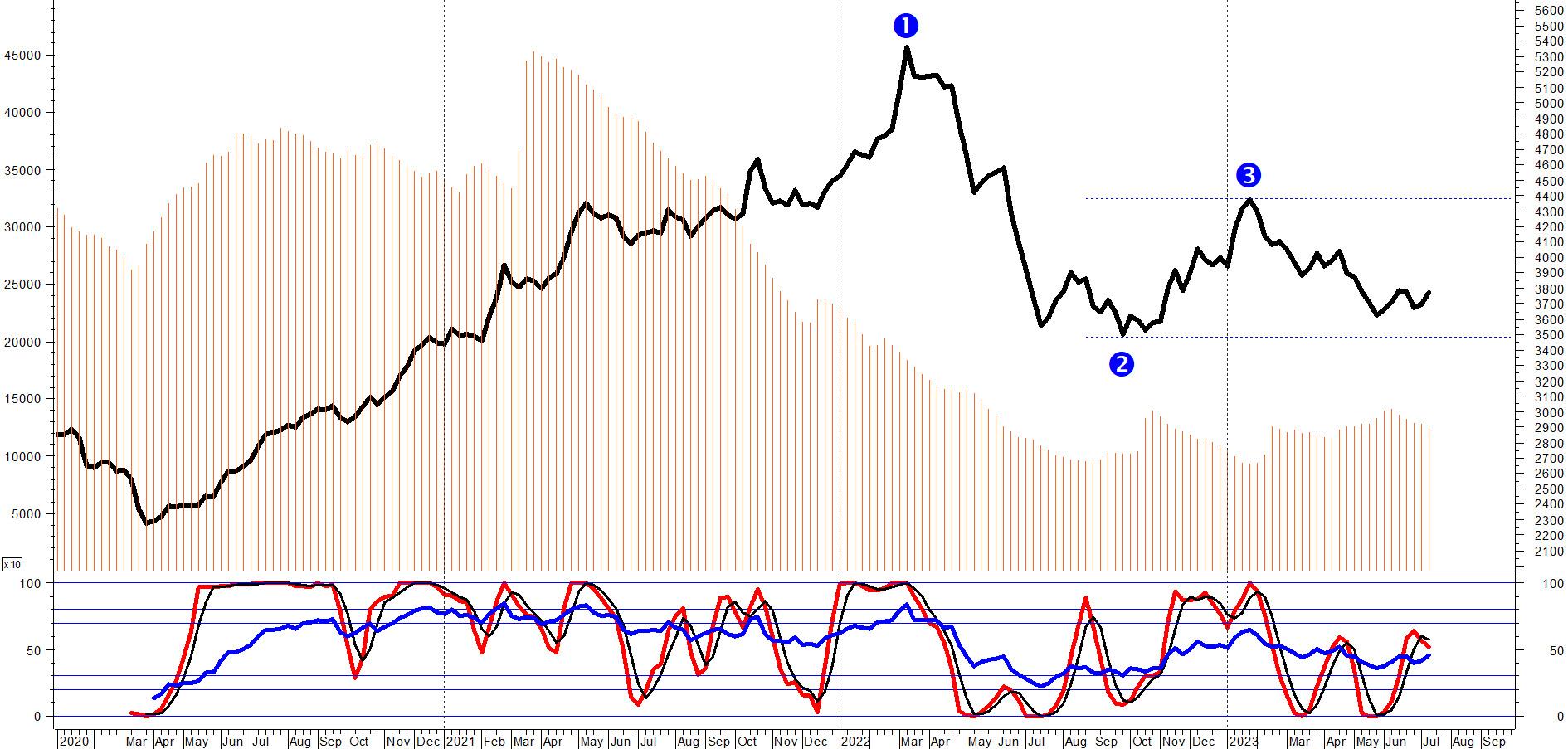
Ferro-Manganese: +144,3% da luglio 2020 a marzo 2022; -56,7% a luglio 2023.
Ferro-Tungsteno: +106% da luglio 2020 a marzo 2022; -28,8% a luglio 2023.
Ferro-Vanadio: +173% da luglio 2020 a marzo 2022; -47,9% a luglio 2023.
Come si evince dall’entità dei rialzi verificatisi tra il 2020 e il 2022, l’ansia da approvvigionamento si è fatta sentire oltre ogni misura, esprimendo sui mercati di ciascuna ferrolega stati di ipercomprato, cioè di eccesso rialzista, mai osservati nel passato. La situazione sembra per il momento essersi stabilizzata, ma non si può escludere che una rinnovata domanda di acciai speciali possa riproporre nuove fasi ascendenti ancorché connotate da velocità e da accelerazione più equilibrate rispetto al recente passato.
Steel and metals: market dynamics, cycles and trends
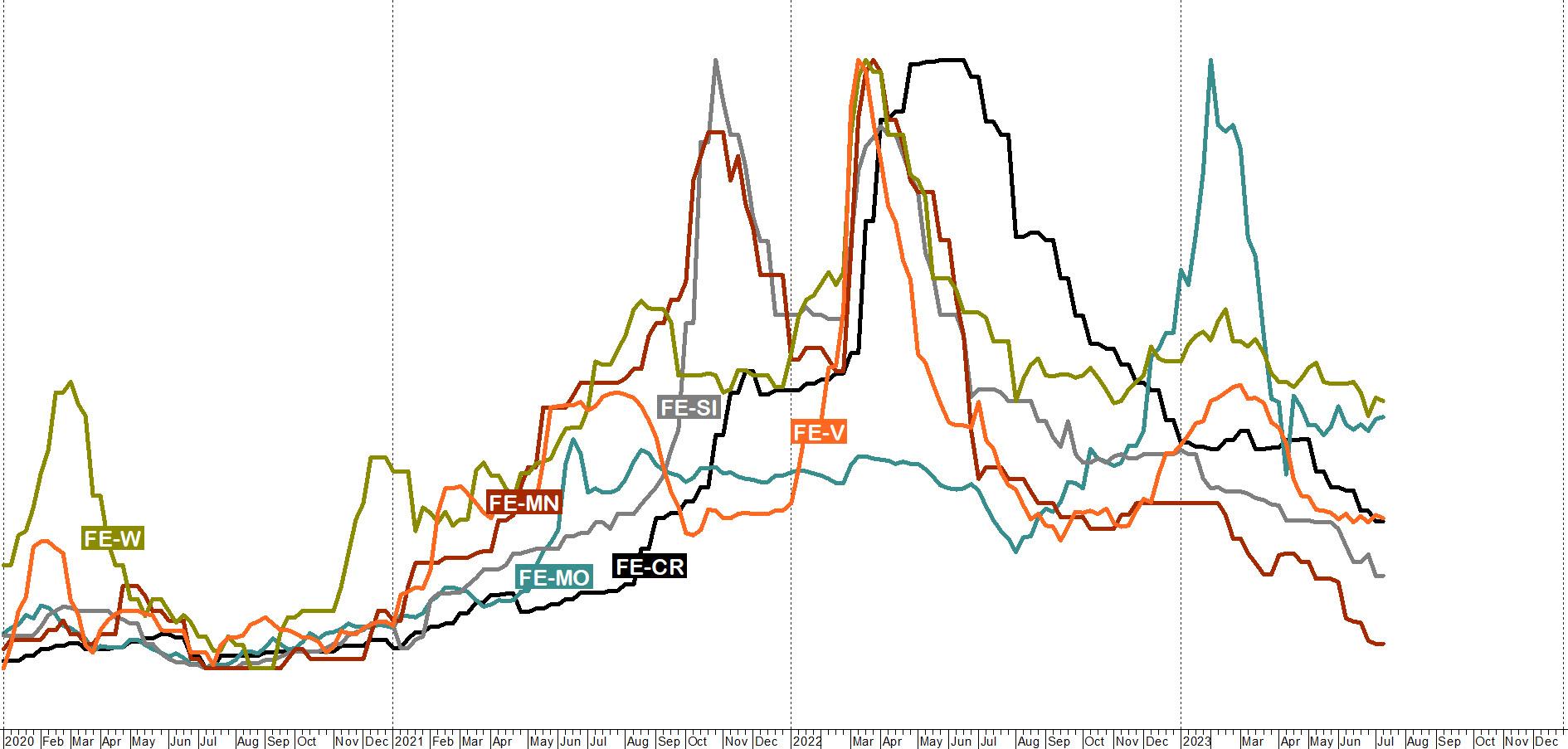
Il comparto degli acciai inossidabili
L’aver esaminato gli andamenti del nickel e di altri elementi tipici delle principali ferroleghe, ci consente di verificare come tali dinamiche abbiano influenzato le produzioni di acciaio inossidabile: materiale meglio resistente ai processi ossidativi e corrosivi rispetto al comune acciaio non legato.
La differenziazione dei diversi acciai inossidabili dipende ovviamente dalla presenza e dal peso di ciascun elemento costituente la lega. A tale riguardo la nomenclatura
AISI - acronimo dell’American Iron & Steel Instituteconsente di distinguere le diverse tipologie di acciaio inox. Nella figura 3, a titolo esemplificativo, sono illustrate le dinamiche dei prezzi rilevati da Siderweb di alcuni prodotti piani inox: le lamiere a freddo 304, 316 e 430. La prima tipologia è imperniata su cromo e nickel, la seconda è basata su cromo, nickel e molibdeno, mentre la terza è fondata sul solo cromo.
Come si può osservare, il mercato delle lamiere inox è stato caratterizzato dai forti incrementi dei prezzi iniziati a metà 2020 ed esauritisi nel mese di marzo 2022 immediatamente dopo l’accelerazione rialzista causata dallo scoppio della guerra in Ucraina. I rialzi iniziano esattamente tre anni fa per concludersi nel mese di marzo 2022: +191,7% le lamiere AISI 304, +158,8% le lamiere
AISI 316, +154,2% le lamiere AISI 430. Rincari tali da scoraggiare la domanda, che in effetti si è prodotta in un vertiginoso calo a partire dalla fine del primo trimestre dello scorso anno, accompagnato dal contestuale ridimensionamento dei prezzi del rottame ferroso, del cromo e del nickel. L’impennata dei prezzi del molibdeno verificatasi nel primo trimestre di quest’anno ha solo rallentato il declino dei valori delle lamiere AISI 316, che si sono peraltro riportati successivamente al ribasso unitamente a quelli degli altri due mercati: a metà luglio 2023 di sono così consolidati esiti di vera e propria depressione: -58% le lamiere AISI 304, -49,2% le lamiere AISI 316, -47,1% le lamiere AISI 430. Ribassi pesanti spiegabili non solo dalla rarefazione della domanda, ma anche, come peraltro accaduto ai metalli non ferrosi del London Metal Exchange, con l’eccesso di stoccaggi effettuati durante la fase euforica del mercato. Per i prossimi mesi ci si attende peraltro un graduale ritorno all’equilibrio tra domanda e offerta per effetto dei rallentamenti produttivi e del probabile lento recupero dei prezzi del rottame ferroso nel quarto trimestre dell’anno.
Ma per osservare una più solida ripresa dei mercati dei metalli non ferrosi e degli acciai inossidabili occorrerà attendere, come del resto per tutti i mercati delle materie prime, il ritorno delle politiche monetarie espansive:
l’incremento del costo del denaro indotto dalle manovre delle banche centrali volte al controllo dell’inflazione, ha infatti contribuito a scoraggiare la propensione agli investimenti, tra i quali la ricostituzione delle scorte. E fino a

quando i tassi si manterranno alti gli acquisti si limiteranno ai soli fabbisogni correnti con impatti modesti sulle dinamiche dei prezzi di mercato.
Nel prossimo appuntamento di questa rubrica (dicembre) saranno sintetizzati gli esiti di fine 2023 e delineate le possibili linee di sviluppo delle diverse filiere siderurgiche e metallurgiche nel 2024. Per le domande e i sempre graditi confronti: : achille.fornasini@unibs.it
TORNA ALL'INDICE >
co-organised by

17TH INTERNATIONAL CONFERENCE ON SEMI SOLID PROCESSING OF ALLOYS AND COMPOSITES


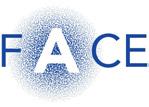
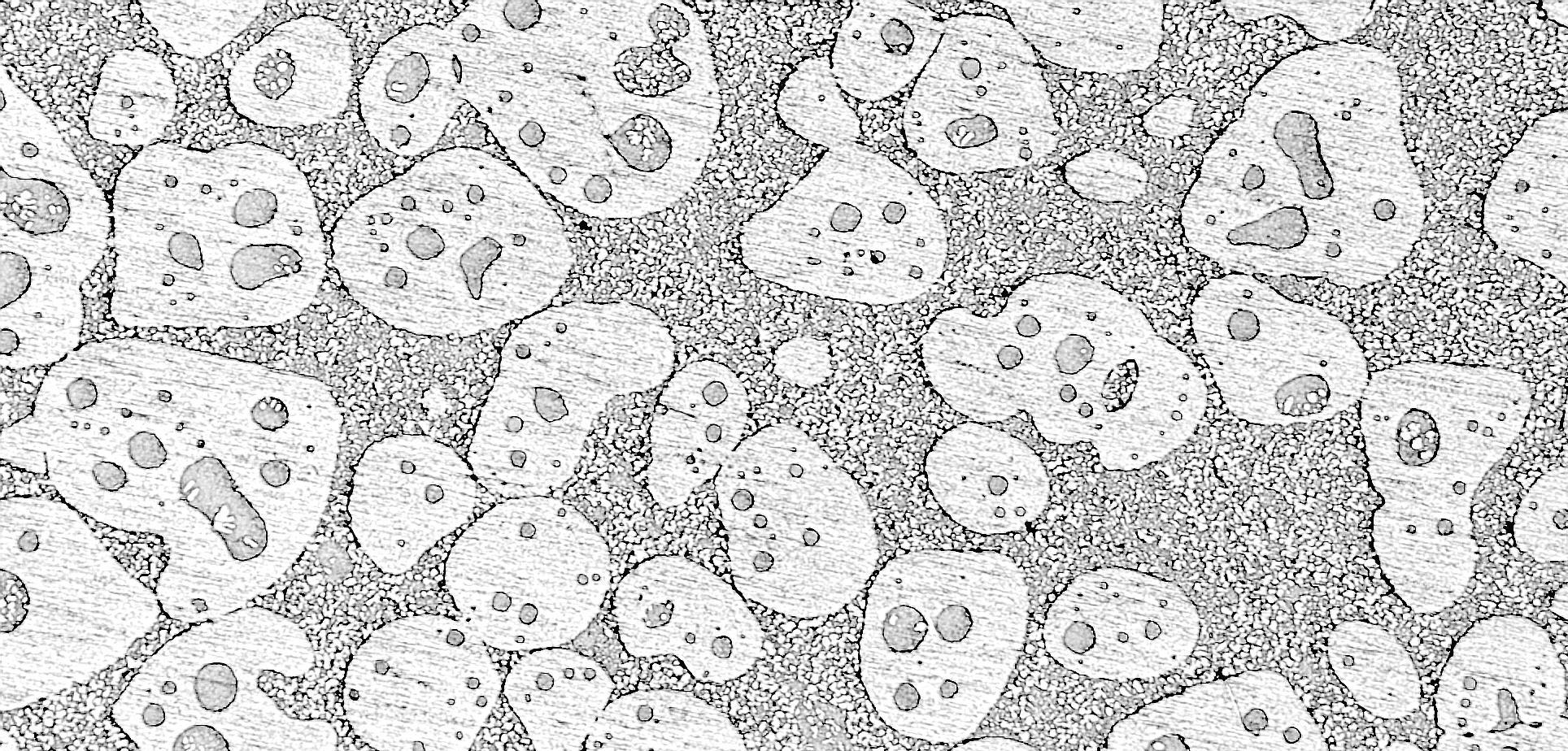
BRESCIA · ITALY, 6-8 SEPTEMBER 2023
On behalf of the Organizing Committee, we are pleased to invite you to the 17th International Conference on Semi Solid Processing of Alloys and Composites (S2P2023), which will be held from September 6th to 8th, 2023 in Brescia, Italy. The 17th S2P International Conference focuses on the advancement in fundamental knowledge and development of materials and industrial processes for semi-solid manufacturing of high-performance metal components. This conference will continue a successful series of conferences on semi-solid processing of alloys and composites started in 1990. The Conference is devoted to all aspects of semi-solid processing of metals alloys and composites with emphasis on basic research, engineering application as well as market aspects. Results of engineering research and experience as well as scientific issues are relevant for the conference.

REGISTER AND JOIN THE CONFERENCE HERE >> www.aimnet.it/s2p/
ORGANISING SECRETARIAT
Via Filippo Turati 8 20121 Milano Italy
Tel. +39 0276021132 or 0276397770
met@aimnet.it . www.aimnet.it/s2p/
SPONSORED BY
SUPPORTERS & MEDIA PARTNERS
Eventi AIM / AIM events
CONVEGNI
S2P 2023 INTERNATIONAL CONFERENCE ON SEMISOLID PROCESSING OF ALLOYS AND COMPOSITES –Brescia, 6-8 settembre 2023 http://www.aimnet.it/s2p/
International Workshop on HIGH STRENGTH STEELS – Bergamo - KilometroRosso, 26-27 ottobre 2023 http://www.aimnet.it/hss23.htm
International Meeting EAF: PRODUCTIVITY, ENERGY EFFICIENCY, RAW MATERIALS AND DECARBONIZATION – Bergamo, 30 novembre-1 dicembre 2023
CORSI E GIORNATE DI STUDIO
Giornata di Studio MATERIALI INNOVATIVI PER IL MONDO RACING – Milano, 4 settembre
Giornata di Studio PROCESSI POST STAMPA ADDITIVA: DAL DESIGN DEL CICLO DI PRODUZIONE AL MANUFATTO – Caravaggio BG c/o TAV, 19 settembre e Nembro BG c/o GFM, 20 settembre
Giornata di Studio STATO DI SERVIZIO DEGLI IMPIANTI, CON PARTICOLARE ATTENZIONE ALLA METALLURGIA E AGLI ESAMI UTILIZZATI – Milano, 27 settembre
Corso itinerante METALLURGIA SICURA – Aosta c/o Cogne Acciai Speciali, Lonato-Calvisano BS c/o Feralpi Siderurgica, Brescia c/o ORI Martin - 28 settembre e 5-12-19 ottobre
Giornata di Studio PREVENZIONE E RIDUZIONE DELLE DEFORMAZIONI IN SALDATURA – Genova, 28 settembre c/o Istituto Italiano di Saldatura
Corso MASTER PROGETTAZIONE STAMPI – ibrido, 6-25-26 ottobre, 8-29-30 novembre, 13 dicembre, 6-7-21 febbraio 2024
Giornata di Studio INNOVAZIONE DEI MATERIALI NELLA MOBILITA’ ELETTRICA – Bologna, 10 ottobre
Giornata di Studio MATERIALI PER IL NUCLEARE (FISSIONE) – Milano, 12 ottobre
HARD METAL CENTURY CELEBRATION & WORKSHOP – Pallanza VB, 12-13 ottobre
Giornata di Studio DIFFRATTOMETRIA A RAGGI X APPLICATA AI TRATTAMENTI TERMOCHIMICI ED ALLA
PALLINATURA CONTROLLATA – Agrate Conturbia (NO) c/o GNR, 17 ottobre
Corso ANALISI CHIMICHE – Milano, 18-19 ottobre
Giornata di Studio IMPIANTI AUTOMATICI PER LA LAVORAZIONE DELL’ACCIAIO NELL'AMBITO DELLA
TECNOLOGIA AVANZATA – Gazzada Schianno VA presso Ficep SpA, 20 ottobre
Giornata di Studio STATO DELL'ARTE ED EVOLUZIONE DEI PROCESSI TERMICI E MECCANICI – Pisa, 8 novembre
Giornata di Studio CARATTERIZZAZIONE FUNZIONALE DI SUPERFICI MODIFICATE – Rovigo c/o Laboratorio
TESI, 15 novembre
Giornata di Studio RIPARAZIONI TRAMITE SALDATURA – Milano, 22 novembre
Giornata di Studio IL MONDO INDUSTRIAL: ASPETTI METALLURGICI E METODOLOGIE DI CONTROLLO –Torino c/o CNH Industrial Village, 5 dicembre
Per ulteriori informazioni rivolgersi alla Segreteria AIM, e-mail: info@aimnet.it, oppure visitare il sito internet www.aimnet. it
FaReTra (Fair Remote Training) - FORMAZIONE E AGGIORNAMENTO A DISTANZA
Modalità Asincrona (registrazioni)
Giornata di Studio EMERGENZA COSTI ENERGETICI: CHE FARE IN FONDERIA?
Webinar FaReTra IL PRINCIPIO DI MATERIALITÀ NEL REPORTING DI SOSTENIBILITÀ
Giornata di Studio ASPETTI E GESTIONE DELLA NORMATIVA NEL CAMPO DEI TRATTAMENTI TERMICI
Corso PROVE NON DISTRUTTIVE
Giornata di Studio TRATTAMENTI SUPERFICIALI SU ALLUMINIO, A SCOPO DECORATIVO E PROTETTIVO
Corso Modulare METALLOGRAFIA – I MODULO, II MODULO “METALLI NON FERROSI”
Corso modulare FONDERIA PER NON FONDITORI
Corso TRIBOLOGIA INDUSTRIALE – I MODULO
Giornate di Studio GETTI PRESSOCOLATI PER APPLICAZIONI STRUTTURALI
Corso DIFETTOLOGIA NEI GETTI PRESSOCOLATI: METALLIZZAZIONI
Corso ADDITIVE METALLURGY
Corso METALLURGIA PER NON METALLURGISTI
Giornata di Studio PRESSOCOLATA IN ZAMA
Giornata di Studio LA SFIDA DELLA NEUTRALITÀ CARBONICA
Corso itinerante METALLURGIA SICURA
Corso modulare TRATTAMENTI TERMICI
Corso modulare I REFRATTARI E LE LORO APPLICAZIONI
Corso GLI ACCIAI INOSSIDABILI 11ª edizione
Corso FAILURE ANALYSIS 11a edizione
Giornata di Studio PERFORMANCE E DEGRADO DEI MATERIALI METALLICI UTILIZZATI IN CAMPO EOLICO: CAPIRE PER PREVENIRE
L’elenco completo delle iniziative è disponibile sul sito: www.aimnet.it
(*) In caso non sia possibile svolgere la manifestazione in presenza, la stessa verrà erogata a distanza in modalità webinar
Comitati tecnici / Study groups
CT CORROSIONE (C) (riunione del 12 maggio 2023)
Consuntivo di attività svolte
• La scuola sulle “Tecniche elettrochimiche per lo studio della corrosione” si è tenuta all’Università di Ferrara dal 7 al 9 febbraio 2023. Il giudizio fornito dai partecipanti sull’evento è stato molto positivo. La scuola ha fatto registrare una notevole partecipazione di persone provenienti dalle università, soprattutto studenti di dottorato. Inoltre, ci sono state persone provenienti da una quindicina di aziende e una dall’aeronautica militare.
• Il 9 marzo 2023 si è tenuta la giornata di studio dal titolo “Verifica e manutenzione di strutture metalliche storiche: aspetti strutturali e metallurgici, diagnostica e tecniche di intervento” organizzata dalla collaborazione tra AIM, CTA e Istituto Italiano di Saldatura. L’iniziativa ha previsto interventi sulla metallurgia, sulla corrosione e protezione e sulla storia delle strutture. Nell’occasione, si è proposto di pubblicare un numero speciale de La Metallurgia Italiana con i contributi presentati nel corso dell’evento.
Manifestazioni in corso di organizzazione
• XV Giornate Nazionali sulla Corrosione e Protezione (Torino – 5-7 luglio 2023). Bassani illustra il programma del convegno, gli eventi sociali e le quote di iscrizione. Ad oggi sono state inviate ad AIM circa 30 memorie e ne mancano diverse altre, considerando i contributi previsti nel programma: probabilmente non tutti i partecipanti scriveranno tutti gli articoli corrispondenti agli abstract inviati. La segreteria AIM spedirà per e-mail un promemoria. I coordinatori delle sessioni saranno anche i revisori per gli articoli che saranno pubblicati ne “La Metallurgia Italiana”, i cui numeri di settembre e novembre 2023 saranno dedicati alla corrosione. Oltre alle presentazioni orali, sono previsti anche cinque poster. Bolzoni ricorda che bisogna definire la commissione per assegnare il premio intitolato a Cecilia Monticelli ai giovani ricercatori per la migliore presentazione orale.
Iniziative future
• Il corso base sulla corrosione, già tenuto in passato, potrebbe essere previsto per fine gennaio o inizio febbraio 2024, periodo favorevole data la sospensione delle lezioni: per procedere in tal senso bisogna iniziare con l’organizzazione da subito con un gruppo ristretto di coordinatori.
• Nelle precedenti riunioni era stato ipotizzato un corso di corrosione che trattasse le prove che fanno riferimento a specifiche norme, in collaborazione con i membri del CT che provengono dalle aziende. Frigo si impegnerà a interpellare altri colleghi dell’industria dove sono presenti dei laboratori per prove di corrosione.
• Il corso sulle tecniche elettrochimiche sarà riproposto nel 2025.
CENTRO RIVESTIMENTI E TRIBOLOGIA (R) (riunione del 26 giugno 2023)
Consuntivo di attività svolte
• Corso “Rivestimenti” – 1° modulo “Film sottili”: la manifestazione si è svolta a Rivoli (TO) l’8 e 9 giugno 2023. Il presidente condivide i risultati dei questionari di valutazione del corso, compilati da 10 partecipanti, con riscontri decisamente positivi relativamente al gradimento dell’evento, alla chiarezza delle presentazioni e alla qualità del materiale fornito, e alla sede scelta. Sono state fornite indicazioni per l’approfondimento di tematiche come test di usura, nanoindentazione, scratch test, che sono già previste nella giornata sulla caratterizzazione delle superfici in via di organizzazione. Vengono discussi altri suggerimenti quali la progettazione dell’architettura dei rivestimenti, gli impieghi del PVD nel settore aeronautico e il rivestimento di utensili con CVD termico.
Manifestazioni in corso di organizzazione
• GdS sulla caratterizzazione delle superfici: viene ripercorsa la bozza di scaletta emersa dalla precedente riunione e le proposte finora pervenute per i possibili relatori. Si prendono quindi decisioni relative ai dettagli dei vari interventi tenendo conto della disponibilità di temi e oratori, e si definisce il programma della giornata che sarà condiviso con il Presidente del CT Controllo e Caratterizzazione Prodotti (CCP), Giantonio Toldo per verificare un eventuale interesse del CT CCP a contribuire alla giornata, in particolare su misura diffrattometrica delle tensioni residue, spettroscopia Raman e caratterizzazione dei rivestimenti su veicoli da competizione. Per la sede, si conferma la disponibilità del laboratorio Te.Si. dell’Università di Padova. Si propone, come potenziale data dell’evento, il 15 Novembre 2023.
CT CONTROLLO E CARATTERIZZAZIONE PRODOTTI (CCP)
(riunione telematica del 07 marzo 2023)
Consuntivo di attività svolte
• Corso “Failure Analysis” (Milano 16, 17 e 23 maggio 2023 in modalità mista - coordinatrici Bisaglia e Ferrari). Il corso ha registrato meno iscrizioni rispetto alla precedente edizione. Ci sono state 10 risposte ai questionari di soddisfazione, tutte positive. Si discute su alcune proposte di miglioramento per le prossime edizioni: non è il caso di procedere ad approfondimenti specifici, trattandosi di un corso introduttivo, in quanto esistono corsi e giornate dedicati. Si pensa alla possibilità di un’esercitazione, partendo da un pezzo difettoso per spiegare come procedere, che esami prevedere, che tagli fare ecc. tutti pensano che sia opportuno ripristinare la visita programmata al laboratorio perché la modalità di proporla libera in un secondo momento non ha portato risultati.
Manifestazioni in corso di organizzazione
• GdS sullo stato di servizio degli impianti (Milano, 27 settembre 2023 esclusivamente in presenza). I coordinatori Giroletti e Bertolini illustrano il programma. Si discute molto della organizzazione del corso in presenza o in modalità mista: alcuni pensano che con tutti i partecipanti in presenza la qualità del corso risulta più elevata, altri pensano che la partecipazione in remoto migliori la divulgazione e dia valore aggiunto se i docenti miglioreranno le modalità di esposizione.
Iniziative future
• Corso “Analisi chimiche” – coordinatore Stella: saranno presenti rappresentanti degli strumenti, che potranno presentare in 10 minuti le tecniche analitiche. Anche per questo motivo la partecipazione sarà necessariamente in presenza. Il programma ricalcherà quello della precedente edizione.
CT TRATTAMENTI TERMICI E METALLOGRAFIA (TTM)
(riunione ibrida del 16 marzo 2023)
Notizie dal Comitato
• Alla riunione è presente Arianna Gotti di Transvalor, che si presenta: l’assemblea dà parere positivo al suo ingresso nel CT TTM.
Consuntivo di attività svolte
• Corso “Metallurgia di base propedeutica ai trattamenti termici”. C’è stata una buona partecipazione (circa 35 in aula e alcuni collegati da remoto). Anche per questa manifestazione si è evidenziata la differenza presenza/remoto. Tutti concordano che la parte svolta in presenza ha coinvolto molto di più i partecipanti, anche perché dopo il primo intervento è più facile per la platea partecipare attivamente alla discussione; i relatori hanno infatti ricevuto tante domande.
• Convegno ECHT 2023 (Genova, 29-31 maggio 2023). Ci sono stati circa 180 partecipanti, un numero molto importante, che si somma ai numerosi espositori anche stranieri, perfino dalla Cina. L’area delle presentazioni era affollata e ben separata da quella degli interventi commerciali. Si discute della possibilità di avere più tempo per le discussioni dopo le presentazioni.
• GdS “Sostenibilità nella produzione di componenti meccanici” – coordinatrice Costanza Colombo – 21 giugno 2023 presso la Società Agrati di Veduggio (LC). Chi era presente ha definito la manifestazione molto interessante, ottima dal punto di vista tecnico e qualitativo, in particolare per le memorie proposte, ed eccellente in quanto ad organizzazione e modalità̀ di svolgimento. Ottima anche la partecipazione numerica. Molti i ringraziamenti alla Agrati per l’accoglienza e molti i complimenti all’ing. Costanza Colombo per la perfetta organizzazione.
Manifestazioni in corso di organizzazione
• GdS “Il Mondo Industrial - aspetti metallurgici e metodologie di controllo” (IVECO CNH Torino, 6 dicembre 2023 – coordinatrice Ecclesia). La manifestazione è stata rinviata diverse volte, sia per la pandemia che per aspetti logistici e di accoglienza. Pur essendo il programma fissato da tempo, alcuni interventi saranno modificati per disponibilità dei relatori: si affronteranno temi relativi a trattamenti termici innovativi e a materiali più performanti che al momento non sono completamente inseriti nel mondo industrial, ma si ha sentore che nel prossimo futuro potranno essere all’ordine del giorno. La formula prevede presentazioni al mattino e tour in azienda al pomeriggio.
• GdS “Stato dell’arte ed evoluzione dei processi termici e meccanici” si svolgerà l’8 novembre 2023 presso il Centro Congressi di Pisa – coordinatore Enrico Morgano – vista la indisponibilità della proprietà Piaggio ad ospitare la manifestazione. Nel programma sono previsti interessanti presentazioni, tra cui una sugli effetti della pallinatura controllata sulla resistenza a fatica di superleghe base Nickel e una sulla diffrattometria.
• GdS “Post-processing dei componenti realizzati in additive” – 19 e 20 settembre 2023 – in collaborazione con CT “Metallurgia delle
polveri e Tecnologie additive”, coordinatori Vicario e Stortieri. La manifestazione si svolgerà il 19 settembre ad Agnadello (CR) con visita nel pomeriggio agli impianti della TAV di Caravaggio, e il 20 settembre a Nembro (BG) con visita nel pomeriggio agli impianti della GFM.
• GdS “Diffrattometria a raggi X applicata ai trattamenti termochimici ed alla pallinatura controllata”, organizzata da GNR ad Agrate Conturbia (NO), con lo scopo di illustrare lo stato dell’arte della diffrattometria a raggi X nel mondo dell’industria meccanica, con particolare accento sulla misurazione dell’austenite residua e delle tensioni residue.
Iniziative future
• Nella primavera 2024 è prevista la ripetizione triennale del corso di metallurgia di base.
Thermal Process Modeling and Simulation
AIM is pleased to announce the 4th Mediterranean Conference on Heat Treatment and Surface Engineering (MCHTSE 2024) and the 5th International Conference on Thermal Process Modeling and Simulation (TPMS-5).
The two IFHTSE Conferences will be held together in Lecce - Italy, on 17-19 April 2024.

The two conferences aim at providing a forum within which engineers, scientists, researchers and production managers can review and discuss fundamentals, new challenges, recent progress and emerging topics in the fields of advanced heat treatment and surface engineering technology.
IMPORTANT DATES
Abstracts Submission Deadline: October 31, 2023
Notification of acceptance: December 15, 2023
Preliminary program: January 31, 2024
Full Papers Submission Deadline: February 28, 2024
www.aimnet.it/mc-tmp.htm
Normativa / Standards
di prova strumentato
UNI EN ISO 3785:2006
Materiali metallici - Designazione degli assi del provino in relazione alla struttura del prodotto
Norme UNSIDER pubblicate da CEN e ISO nel mese di giugno 2023
UNI EN 10225-3:2023
Acciai strutturali saldabili destinati alla costruzione di strutture fisse in mareCondizioni tecniche di fornitura - Parte 3: Profilati cavi finiti a caldo
UNI EN 13480-3:2023
Tubazioni industriali metalliche - Parte 3: Progettazione e calcolo
UNI EN ISO 14556:2023
Materiali metallici - Prova di resilienza su provetta Charpy con intaglio a V - Metodo di prova strumentato
UNI EN ISO 3785:2023
Materiali metallici - Designazione degli assi del provino in relazione alla struttura del prodotto
UNI EN 17800:2023
Il Costo del Ciclo di Vita (LCC) e l'Analisi del ciclo di vita (LCA) per le emissioni di CO2 nei sistemi di tubazioni in ghisa sferoidale
Norme UNSIDER ritirate con sostituzione da UNI nel mese di giugno 2023
UNI EN 13480-3:2022
Tubazioni industriali metalliche - Parte 3: Progettazione e calcolo
UNI EN ISO 14556:2015
Materiali metallici - Prova di resilienza su provetta Charpy con intaglio a V - Metodo
UNI EN 10225-3:2019
Acciai strutturali saldabili destinati alla costruzione di strutture fisse in mareCondizioni tecniche di fornitura - Parte 3: Profilati cavi finiti a caldo
Norme UNSIDER pubblicate da CEN e ISO nel mese di giugno 2023
EN 14870-1:2023
Petroleum and natural gas industriesInduction bends, fittings and flanges for pipeline transportation systems - Part 1: Induction bends (ISO 15590-1:2018, modified)
EN 14870-4:2023
Petroleum and natural gas industriesInduction bends, fittings and flanges for pipeline transportation systems - Part 4: Factory cold bends (ISO 15590-4:2019, modified)
CEN/TR 10377:2023
Guidelines for the preparation of standard routine methods with wavelength-dispersive X-ray fluorescence spectrometry
EN 10244-2:2023
Steel wire and wire products - Non-ferrous metallic coatings on steel wire - Part 2: Zinc or zinc alloy coatings
Progetti UNSIDER messi allo studio dal CEN (Stage 10.99) – luglio 2023
EN 14917:2021/prA1
Metal bellows expansion joints for pres-
sure applications
Progetti UNSIDER in inchiesta prEN e ISO/DIS – luglio 2023
prEN – progetti di norma europei
prEN ISO19901-5
Petroleum and natural gas industries - Specific requirements for offshore structures - Part 3: Topsides structure (ISO/DIS 19901-3:2022)
ISO/DIS – progetti di norma internazionali
ISO/DIS 24476
Steel – Determination of oxygen – Infrared absorption method after fusion under inert gas (Routine method)
ISO/DIS 21068-1
Chemical analysis of raw materials and refractory products containing silicon-carbide, silicon-nitride, silicon-oxynitride and sialon — Part 1: General information and sample preparation
ISO/DIS 21068-2
Chemical analysis of raw materials and refractory products containing silicon-carbide, silicon-nitride, silicon-oxynitride and sialon — Part 2: Determination of volatile components, total carbon, free carbon, silicon carbide, total and free silicon, free and surface silica
ISO/DIS 21068-3
Chemical analysis of raw materials and refractory products containing silicon-carbide, silicon-nitride, silicon-oxynitride and sialon — Part 3: Determination of nitrogen, oxygen and metallic and oxidic constituents
Norme pubblicate e progetti in inchiesta (aggiornamento 29 giugno 2023)
ISO/DIS 21068-4
Chemical analysis of raw materials and refractory products containing silicon-carbide, silicon-nitride, silicon-oxynitride and sialon — Part 4: XRD methods
ISO/DIS 16132
FDIS 10113:2019)
Luciano Lazzari
ISO/FDIS – progetti di norma internazionali
Diario di un corrosionista
Appunti, ricordi, polemiche a distanza
ISO/FDIS 19901-8
Petroleum and natural gas industries
Luciano Lazzari Diario di un corrosionista Appunti, ricordi, polemiche a distanza
Ductile iron pipes and fittings — Seal coats for cement mortar linings
ISO 13680:2020/DAmd 1
Petroleum and natural gas industries — Corrosion-resistant alloy seamless tubular products for use as casing, tubing, coupling stock and accessory material — Technical delivery conditions — Amendment 1: Petroleum and natural gas industries — Corrosion-resistant alloy seamless products for use as casing, tubing, coupling stock and accessory material — Technical delivery conditions
— Specific requirements for offshore structures — Part 8: Marine soil investigations
Il testo è la raccolta di riflessioni maturate dall’autore durante l’attività più che quarantennale di ricercatore e di ingegnere della corrosione, allo scopo da una parte di testimoniare l’esperienza maturata e dall’altra esternare le considerazioni critiche su molti aspetti pratici e teorici della disciplina. Sono anche descritte le tappe percorse dall’autore per giungere a risultati che ritiene originali nell’ambito dell’ingegneria della corrosione.
Il testo è la raccolta di riflessioni maturate dall’autore durante l’attività più che quarantennale di ricercatore e di ingegnere della corrosione, allo scopo da una parte di testimoniare l’esperienza maturata e dall’altra esternare le considerazioni critiche su molti aspetti pratici e teorici della disciplina. Sono anche descritte le tappe percorse dall’autore per giungere a risultati che ritiene originali nell’ambito dell’ingegneria della corrosione.
ISO/DIS 11772
Hot rolled longitudinally profiled steel plate
ISO/DIS 6435
Stainless steel bars for the reinforcement of concrete
ISO/DTS 19096
Metallic materials — Instrumented indentation test for hardness and materials parameters — Evaluation of stress change using indentation force differences
ISO/FDIS 15551
Petroleum and natural gas industries
Luciano Lazzari (1948) si è laureato con lode in Ingegneria Chimica al Politecnico di Milano dove ha insegnato Scienza e Tecnologia dei Materiali e Corrosione e Protezione dei Materiali fino al 2015. Svolge attività professionale presso Cescor srl di cui è Presidente. Oltre che autore di numerosi articoli in riviste scientifiche ha pubblicato tra gli altri Engineering Tools for Corrosion (2017) e con Pietro Pedeferri il libro Cathodic Protection (2006). Ha ricevuto due onorificenze: la Medaglia di titanio AIM (2017) e la Medaglia Cavallaro EFC (2022).
— Drilling and production equipment — Electric submersible pump systems for artificial lift
ISO/FDIS 6507-1
Metallic materials — Vickers hardness test
— Part 1: Test method
ISO/FDIS 4545-1
Metallic materials — Knoop hardness test
Luciano Lazzari (1948) si è laureato con lode in Ingegneria Chimica al Politecnico di Milano dove ha insegnato Scienza e Tecnologia dei Materiali e Corrosione e Protezione dei Materiali fino al 2015. Svolge attività professionale presso Cescor srl di cui è Presidente. Oltre che autore di numerosi articoli in riviste scientifiche ha pubblicato tra gli altri Engineering Tools for Corrosion (2017) e con Pietro Pedeferri il libro Cathodic Protection (2006). Ha ricevuto due onorificenze: la Medaglia di titanio AIM (2017) e la Medaglia Cavallaro EFC (2022).
ISO/DIS 4954-1
Steels for cold heading and cold extruding — Part 1: Non-alloy and low alloy steels
ISO/DIS 4954-2
Steels for cold heading and cold extruding — Part 2: Stainless steels
Progetti UNSIDER al voto FprEN e ISO/FDIS – luglio 2023
FprEN – progetti di norma europei
FprEN ISO 10113
Metallic materials - Sheet and stripDetermination of plastic strain ratio (ISO/
— Part 1: Test method
ISO/FDIS 3887
Steels — Determination of the depth of decarburization
ISO/FDIS 683-17
Heat-treatable steels, alloy steels and free-cutting steels — Part 17: Ball and roller bearing steels
Diario di un corrosionista
DIARIO DI UN CORROSIONISTA
Diario di un corrosionista
APPUNTI, RICORDI, POLEMICHE A DISTANZA
Appunti, ricordi, polemiche a distanza
di Luciano Lazzari
ed. AIM - 2022
ISBN: 978-88-98990-30-6
Formato cartaceo
Prezzo di copertina: Euro 14,00
Vol. I
Il testo è la raccolta di riflessioni maturate dall’autore durante l’attività più che quarantennale di ricercatore e di ingegnere della corrosione, allo scopo da una parte di testimoniare l’esperienza maturata e dall’altra esternare le considerazioni critiche su molti aspetti pratici e teorici della disciplina. Sono anche descritte le tappe percorse dall’autore per giungere a risultati che ritiene originali nell’ambito dell’ingegneria della corrosione.


Luciano Lazzari
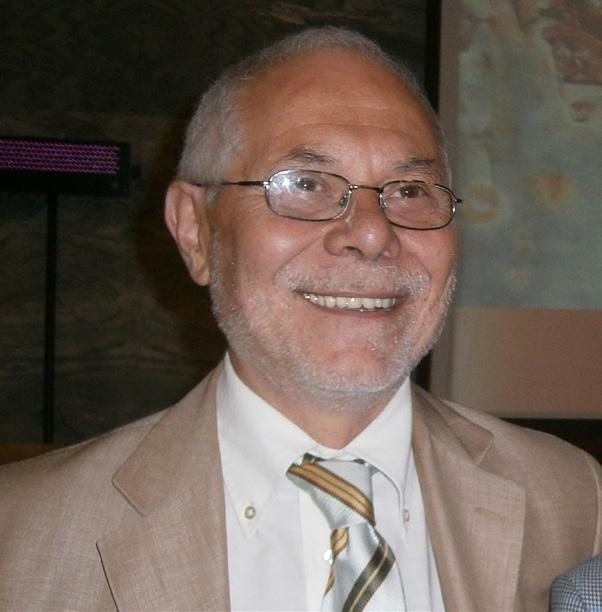
si è laureato con lode in Ingegneria Chimica al Politecnico di Milano dove ha insegnato Scienza e Tecnologia dei Materiali e Corrosione e Protezione dei Materiali fino al 2015. Svolge attività professionale presso Cescor srl di cui è Presidente.
Oltre che autore di numerosi articoli in riviste scientifiche ha pubblicato tra gli altri Engineering Tools for Corrosion (2017) e con Pietro Pedeferri il libro Cathodic Protection (2006). Ha ricevuto due onorificenze: la Medaglia di titanio AIM (2017) e la Medaglia Cavallaro EFC (2022).
Narrativa Tecnica

